Law 1: Climate Change and Indigenous Land Policies in Australia
VerifiedAdded on 2020/05/11
|19
|4705
|78
Report
AI Summary
This report provides a comprehensive analysis of the impact of climate change on indigenous communities in Australia. It begins by outlining the global significance of climate change and its specific threats to indigenous populations, emphasizing the legal and institutional barriers faced. The report explores the adverse effects on health, culture, and livelihoods, highlighting the failure of Australian land policies to adequately recognize the cultural importance of indigenous peoples. It discusses the vulnerability of indigenous populations in the context of climate change, examining the relationship between indigenous communities, land, and the environment. The report covers the impacts of climate change, including forced displacement, loss of traditional lands, and disruption of food security. It also assesses land policies and other government initiatives aimed at mitigating these impacts. The report concludes with a summary of the key findings, underscoring the need for holistic responses that consider ecological, social, and human rights dimensions. The report emphasizes the importance of government support, technical assistance, and the involvement of indigenous communities in developing climate change strategies.

Running Head: Law 1
Law
Law
Paraphrase This Document
Need a fresh take? Get an instant paraphrase of this document with our AI Paraphraser
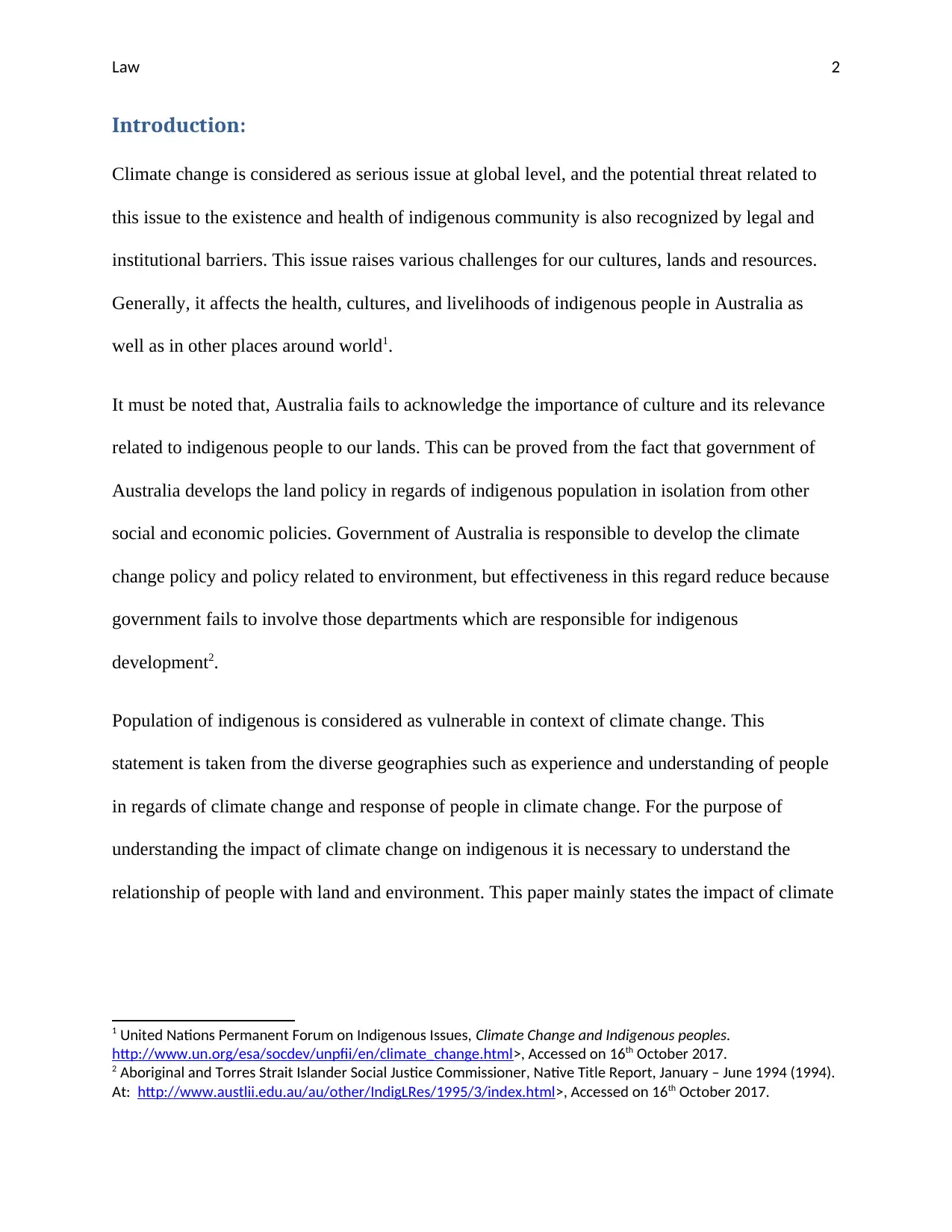
Law 2
Introduction:
Climate change is considered as serious issue at global level, and the potential threat related to
this issue to the existence and health of indigenous community is also recognized by legal and
institutional barriers. This issue raises various challenges for our cultures, lands and resources.
Generally, it affects the health, cultures, and livelihoods of indigenous people in Australia as
well as in other places around world1.
It must be noted that, Australia fails to acknowledge the importance of culture and its relevance
related to indigenous people to our lands. This can be proved from the fact that government of
Australia develops the land policy in regards of indigenous population in isolation from other
social and economic policies. Government of Australia is responsible to develop the climate
change policy and policy related to environment, but effectiveness in this regard reduce because
government fails to involve those departments which are responsible for indigenous
development2.
Population of indigenous is considered as vulnerable in context of climate change. This
statement is taken from the diverse geographies such as experience and understanding of people
in regards of climate change and response of people in climate change. For the purpose of
understanding the impact of climate change on indigenous it is necessary to understand the
relationship of people with land and environment. This paper mainly states the impact of climate
1 United Nations Permanent Forum on Indigenous Issues, Climate Change and Indigenous peoples.
http://www.un.org/esa/socdev/unpfii/en/climate_change.html>, Accessed on 16th October 2017.
2 Aboriginal and Torres Strait Islander Social Justice Commissioner, Native Title Report, January – June 1994 (1994).
At: http://www.austlii.edu.au/au/other/IndigLRes/1995/3/index.html>, Accessed on 16th October 2017.
Introduction:
Climate change is considered as serious issue at global level, and the potential threat related to
this issue to the existence and health of indigenous community is also recognized by legal and
institutional barriers. This issue raises various challenges for our cultures, lands and resources.
Generally, it affects the health, cultures, and livelihoods of indigenous people in Australia as
well as in other places around world1.
It must be noted that, Australia fails to acknowledge the importance of culture and its relevance
related to indigenous people to our lands. This can be proved from the fact that government of
Australia develops the land policy in regards of indigenous population in isolation from other
social and economic policies. Government of Australia is responsible to develop the climate
change policy and policy related to environment, but effectiveness in this regard reduce because
government fails to involve those departments which are responsible for indigenous
development2.
Population of indigenous is considered as vulnerable in context of climate change. This
statement is taken from the diverse geographies such as experience and understanding of people
in regards of climate change and response of people in climate change. For the purpose of
understanding the impact of climate change on indigenous it is necessary to understand the
relationship of people with land and environment. This paper mainly states the impact of climate
1 United Nations Permanent Forum on Indigenous Issues, Climate Change and Indigenous peoples.
http://www.un.org/esa/socdev/unpfii/en/climate_change.html>, Accessed on 16th October 2017.
2 Aboriginal and Torres Strait Islander Social Justice Commissioner, Native Title Report, January – June 1994 (1994).
At: http://www.austlii.edu.au/au/other/IndigLRes/1995/3/index.html>, Accessed on 16th October 2017.
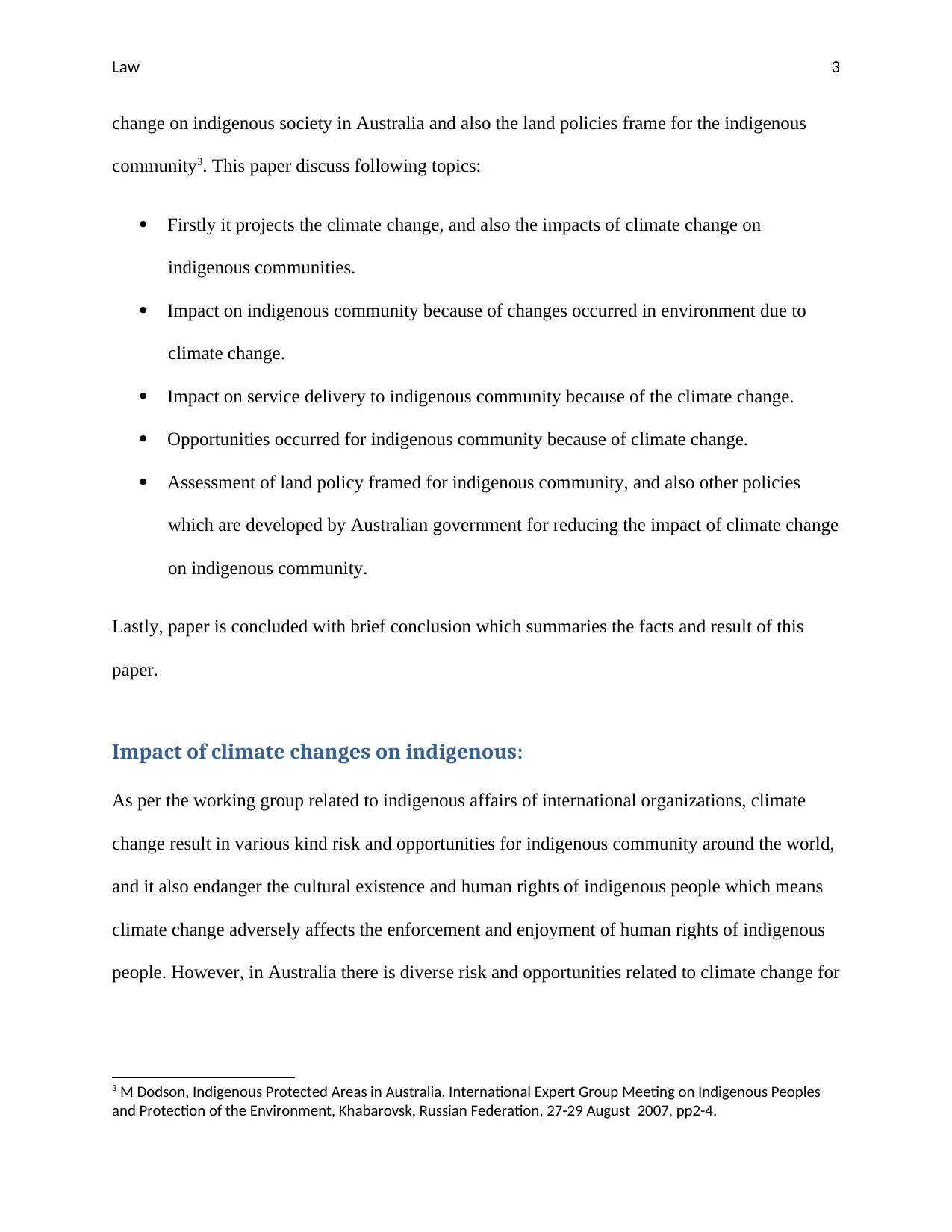
Law 3
change on indigenous society in Australia and also the land policies frame for the indigenous
community3. This paper discuss following topics:
Firstly it projects the climate change, and also the impacts of climate change on
indigenous communities.
Impact on indigenous community because of changes occurred in environment due to
climate change.
Impact on service delivery to indigenous community because of the climate change.
Opportunities occurred for indigenous community because of climate change.
Assessment of land policy framed for indigenous community, and also other policies
which are developed by Australian government for reducing the impact of climate change
on indigenous community.
Lastly, paper is concluded with brief conclusion which summaries the facts and result of this
paper.
Impact of climate changes on indigenous:
As per the working group related to indigenous affairs of international organizations, climate
change result in various kind risk and opportunities for indigenous community around the world,
and it also endanger the cultural existence and human rights of indigenous people which means
climate change adversely affects the enforcement and enjoyment of human rights of indigenous
people. However, in Australia there is diverse risk and opportunities related to climate change for
3 M Dodson, Indigenous Protected Areas in Australia, International Expert Group Meeting on Indigenous Peoples
and Protection of the Environment, Khabarovsk, Russian Federation, 27-29 August 2007, pp2-4.
change on indigenous society in Australia and also the land policies frame for the indigenous
community3. This paper discuss following topics:
Firstly it projects the climate change, and also the impacts of climate change on
indigenous communities.
Impact on indigenous community because of changes occurred in environment due to
climate change.
Impact on service delivery to indigenous community because of the climate change.
Opportunities occurred for indigenous community because of climate change.
Assessment of land policy framed for indigenous community, and also other policies
which are developed by Australian government for reducing the impact of climate change
on indigenous community.
Lastly, paper is concluded with brief conclusion which summaries the facts and result of this
paper.
Impact of climate changes on indigenous:
As per the working group related to indigenous affairs of international organizations, climate
change result in various kind risk and opportunities for indigenous community around the world,
and it also endanger the cultural existence and human rights of indigenous people which means
climate change adversely affects the enforcement and enjoyment of human rights of indigenous
people. However, in Australia there is diverse risk and opportunities related to climate change for
3 M Dodson, Indigenous Protected Areas in Australia, International Expert Group Meeting on Indigenous Peoples
and Protection of the Environment, Khabarovsk, Russian Federation, 27-29 August 2007, pp2-4.
You're viewing a preview
Unlock full access by subscribing today!
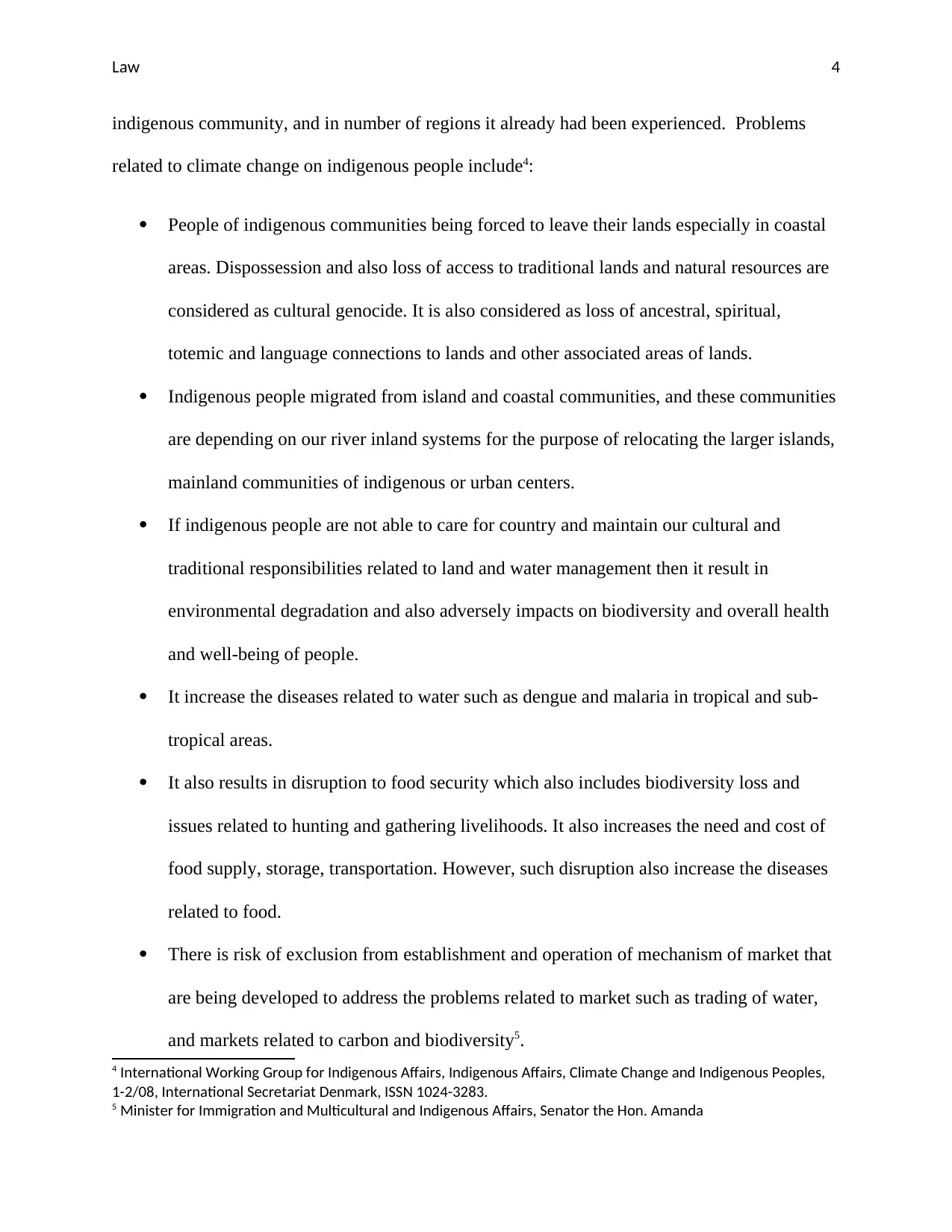
Law 4
indigenous community, and in number of regions it already had been experienced. Problems
related to climate change on indigenous people include4:
People of indigenous communities being forced to leave their lands especially in coastal
areas. Dispossession and also loss of access to traditional lands and natural resources are
considered as cultural genocide. It is also considered as loss of ancestral, spiritual,
totemic and language connections to lands and other associated areas of lands.
Indigenous people migrated from island and coastal communities, and these communities
are depending on our river inland systems for the purpose of relocating the larger islands,
mainland communities of indigenous or urban centers.
If indigenous people are not able to care for country and maintain our cultural and
traditional responsibilities related to land and water management then it result in
environmental degradation and also adversely impacts on biodiversity and overall health
and well-being of people.
It increase the diseases related to water such as dengue and malaria in tropical and sub-
tropical areas.
It also results in disruption to food security which also includes biodiversity loss and
issues related to hunting and gathering livelihoods. It also increases the need and cost of
food supply, storage, transportation. However, such disruption also increase the diseases
related to food.
There is risk of exclusion from establishment and operation of mechanism of market that
are being developed to address the problems related to market such as trading of water,
and markets related to carbon and biodiversity5.
4 International Working Group for Indigenous Affairs, Indigenous Affairs, Climate Change and Indigenous Peoples,
1-2/08, International Secretariat Denmark, ISSN 1024-3283.
5 Minister for Immigration and Multicultural and Indigenous Affairs, Senator the Hon. Amanda
indigenous community, and in number of regions it already had been experienced. Problems
related to climate change on indigenous people include4:
People of indigenous communities being forced to leave their lands especially in coastal
areas. Dispossession and also loss of access to traditional lands and natural resources are
considered as cultural genocide. It is also considered as loss of ancestral, spiritual,
totemic and language connections to lands and other associated areas of lands.
Indigenous people migrated from island and coastal communities, and these communities
are depending on our river inland systems for the purpose of relocating the larger islands,
mainland communities of indigenous or urban centers.
If indigenous people are not able to care for country and maintain our cultural and
traditional responsibilities related to land and water management then it result in
environmental degradation and also adversely impacts on biodiversity and overall health
and well-being of people.
It increase the diseases related to water such as dengue and malaria in tropical and sub-
tropical areas.
It also results in disruption to food security which also includes biodiversity loss and
issues related to hunting and gathering livelihoods. It also increases the need and cost of
food supply, storage, transportation. However, such disruption also increase the diseases
related to food.
There is risk of exclusion from establishment and operation of mechanism of market that
are being developed to address the problems related to market such as trading of water,
and markets related to carbon and biodiversity5.
4 International Working Group for Indigenous Affairs, Indigenous Affairs, Climate Change and Indigenous Peoples,
1-2/08, International Secretariat Denmark, ISSN 1024-3283.
5 Minister for Immigration and Multicultural and Indigenous Affairs, Senator the Hon. Amanda
Paraphrase This Document
Need a fresh take? Get an instant paraphrase of this document with our AI Paraphraser
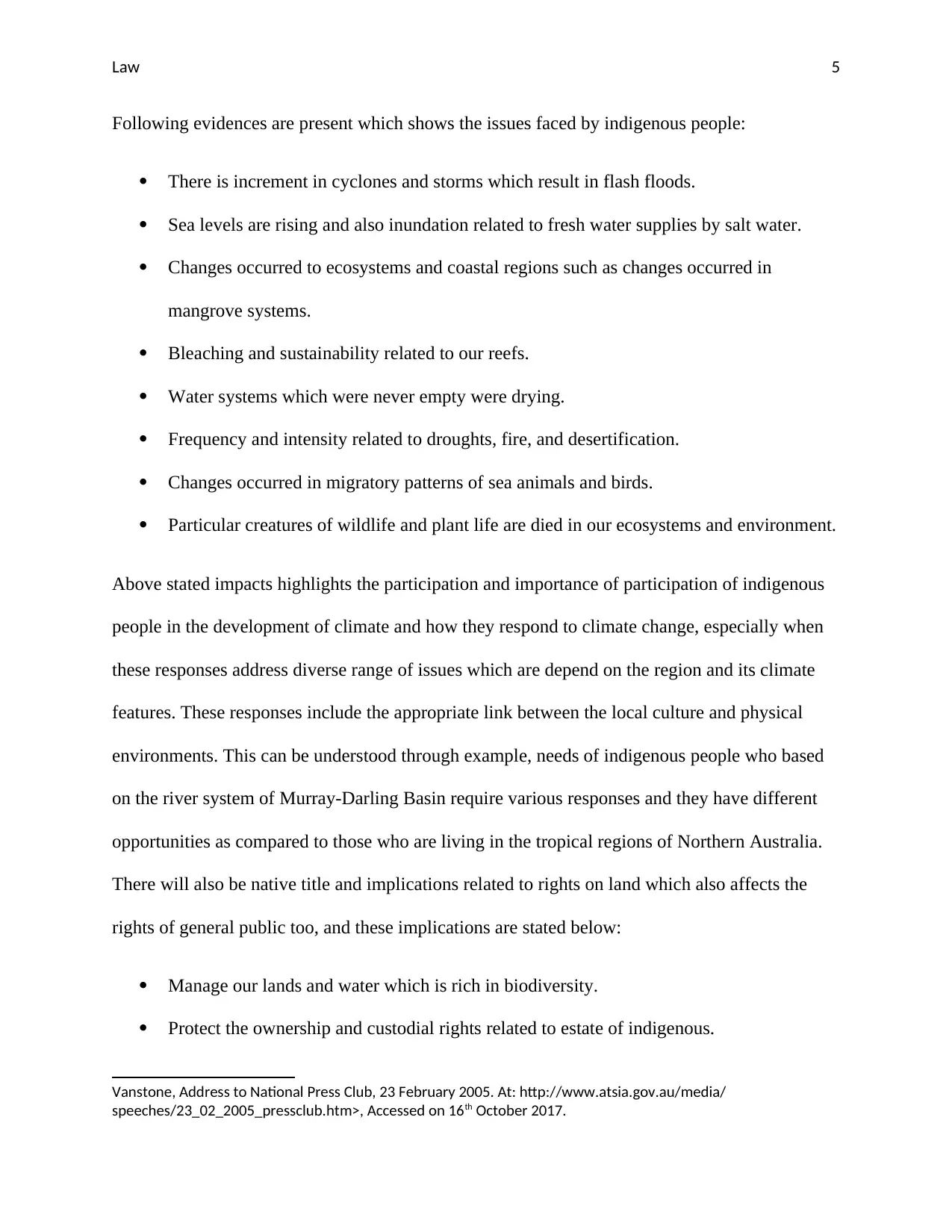
Law 5
Following evidences are present which shows the issues faced by indigenous people:
There is increment in cyclones and storms which result in flash floods.
Sea levels are rising and also inundation related to fresh water supplies by salt water.
Changes occurred to ecosystems and coastal regions such as changes occurred in
mangrove systems.
Bleaching and sustainability related to our reefs.
Water systems which were never empty were drying.
Frequency and intensity related to droughts, fire, and desertification.
Changes occurred in migratory patterns of sea animals and birds.
Particular creatures of wildlife and plant life are died in our ecosystems and environment.
Above stated impacts highlights the participation and importance of participation of indigenous
people in the development of climate and how they respond to climate change, especially when
these responses address diverse range of issues which are depend on the region and its climate
features. These responses include the appropriate link between the local culture and physical
environments. This can be understood through example, needs of indigenous people who based
on the river system of Murray-Darling Basin require various responses and they have different
opportunities as compared to those who are living in the tropical regions of Northern Australia.
There will also be native title and implications related to rights on land which also affects the
rights of general public too, and these implications are stated below:
Manage our lands and water which is rich in biodiversity.
Protect the ownership and custodial rights related to estate of indigenous.
Vanstone, Address to National Press Club, 23 February 2005. At: http://www.atsia.gov.au/media/
speeches/23_02_2005_pressclub.htm>, Accessed on 16th October 2017.
Following evidences are present which shows the issues faced by indigenous people:
There is increment in cyclones and storms which result in flash floods.
Sea levels are rising and also inundation related to fresh water supplies by salt water.
Changes occurred to ecosystems and coastal regions such as changes occurred in
mangrove systems.
Bleaching and sustainability related to our reefs.
Water systems which were never empty were drying.
Frequency and intensity related to droughts, fire, and desertification.
Changes occurred in migratory patterns of sea animals and birds.
Particular creatures of wildlife and plant life are died in our ecosystems and environment.
Above stated impacts highlights the participation and importance of participation of indigenous
people in the development of climate and how they respond to climate change, especially when
these responses address diverse range of issues which are depend on the region and its climate
features. These responses include the appropriate link between the local culture and physical
environments. This can be understood through example, needs of indigenous people who based
on the river system of Murray-Darling Basin require various responses and they have different
opportunities as compared to those who are living in the tropical regions of Northern Australia.
There will also be native title and implications related to rights on land which also affects the
rights of general public too, and these implications are stated below:
Manage our lands and water which is rich in biodiversity.
Protect the ownership and custodial rights related to estate of indigenous.
Vanstone, Address to National Press Club, 23 February 2005. At: http://www.atsia.gov.au/media/
speeches/23_02_2005_pressclub.htm>, Accessed on 16th October 2017.
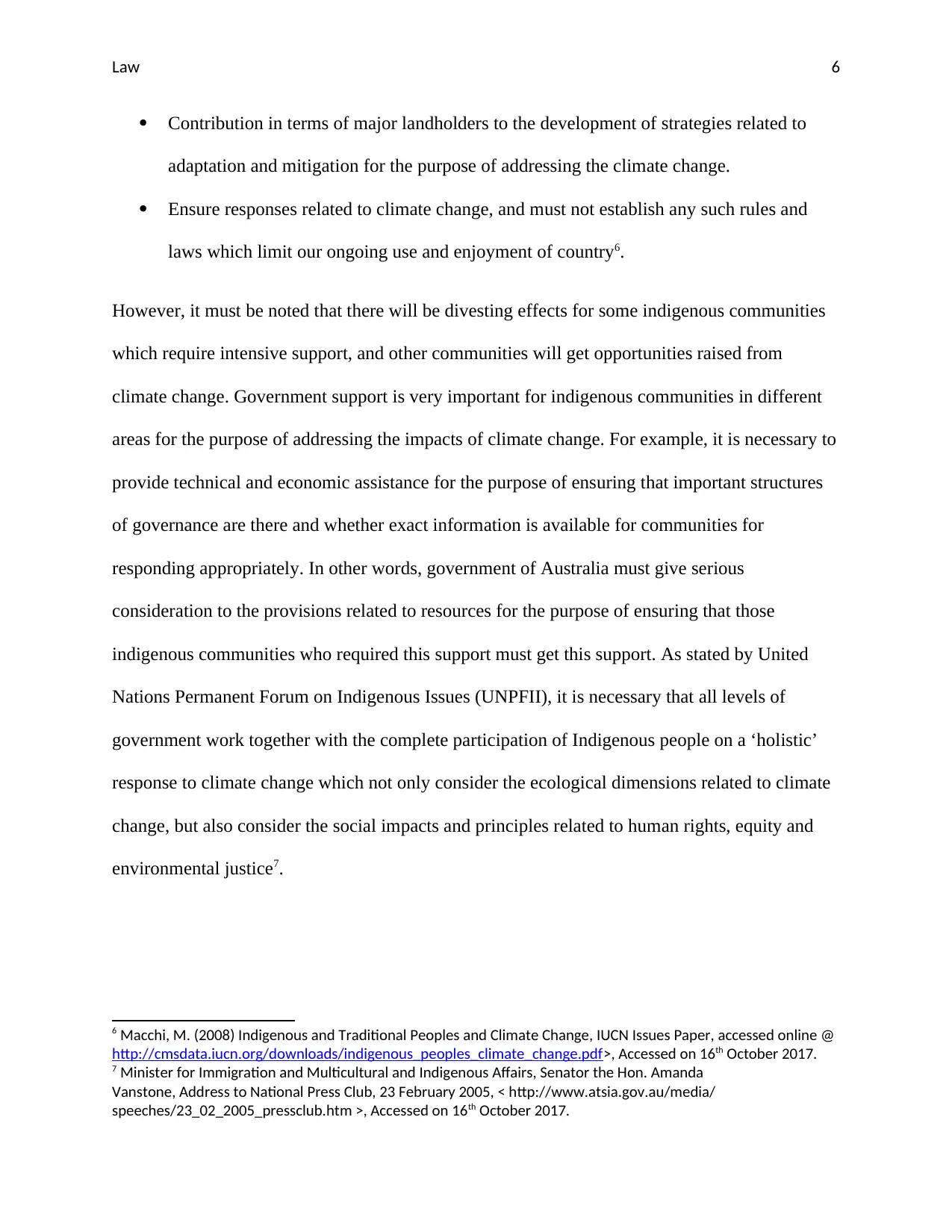
Law 6
Contribution in terms of major landholders to the development of strategies related to
adaptation and mitigation for the purpose of addressing the climate change.
Ensure responses related to climate change, and must not establish any such rules and
laws which limit our ongoing use and enjoyment of country6.
However, it must be noted that there will be divesting effects for some indigenous communities
which require intensive support, and other communities will get opportunities raised from
climate change. Government support is very important for indigenous communities in different
areas for the purpose of addressing the impacts of climate change. For example, it is necessary to
provide technical and economic assistance for the purpose of ensuring that important structures
of governance are there and whether exact information is available for communities for
responding appropriately. In other words, government of Australia must give serious
consideration to the provisions related to resources for the purpose of ensuring that those
indigenous communities who required this support must get this support. As stated by United
Nations Permanent Forum on Indigenous Issues (UNPFII), it is necessary that all levels of
government work together with the complete participation of Indigenous people on a ‘holistic’
response to climate change which not only consider the ecological dimensions related to climate
change, but also consider the social impacts and principles related to human rights, equity and
environmental justice7.
6 Macchi, M. (2008) Indigenous and Traditional Peoples and Climate Change, IUCN Issues Paper, accessed online @
http://cmsdata.iucn.org/downloads/indigenous_peoples_climate_change.pdf>, Accessed on 16th October 2017.
7 Minister for Immigration and Multicultural and Indigenous Affairs, Senator the Hon. Amanda
Vanstone, Address to National Press Club, 23 February 2005, < http://www.atsia.gov.au/media/
speeches/23_02_2005_pressclub.htm >, Accessed on 16th October 2017.
Contribution in terms of major landholders to the development of strategies related to
adaptation and mitigation for the purpose of addressing the climate change.
Ensure responses related to climate change, and must not establish any such rules and
laws which limit our ongoing use and enjoyment of country6.
However, it must be noted that there will be divesting effects for some indigenous communities
which require intensive support, and other communities will get opportunities raised from
climate change. Government support is very important for indigenous communities in different
areas for the purpose of addressing the impacts of climate change. For example, it is necessary to
provide technical and economic assistance for the purpose of ensuring that important structures
of governance are there and whether exact information is available for communities for
responding appropriately. In other words, government of Australia must give serious
consideration to the provisions related to resources for the purpose of ensuring that those
indigenous communities who required this support must get this support. As stated by United
Nations Permanent Forum on Indigenous Issues (UNPFII), it is necessary that all levels of
government work together with the complete participation of Indigenous people on a ‘holistic’
response to climate change which not only consider the ecological dimensions related to climate
change, but also consider the social impacts and principles related to human rights, equity and
environmental justice7.
6 Macchi, M. (2008) Indigenous and Traditional Peoples and Climate Change, IUCN Issues Paper, accessed online @
http://cmsdata.iucn.org/downloads/indigenous_peoples_climate_change.pdf>, Accessed on 16th October 2017.
7 Minister for Immigration and Multicultural and Indigenous Affairs, Senator the Hon. Amanda
Vanstone, Address to National Press Club, 23 February 2005, < http://www.atsia.gov.au/media/
speeches/23_02_2005_pressclub.htm >, Accessed on 16th October 2017.
You're viewing a preview
Unlock full access by subscribing today!
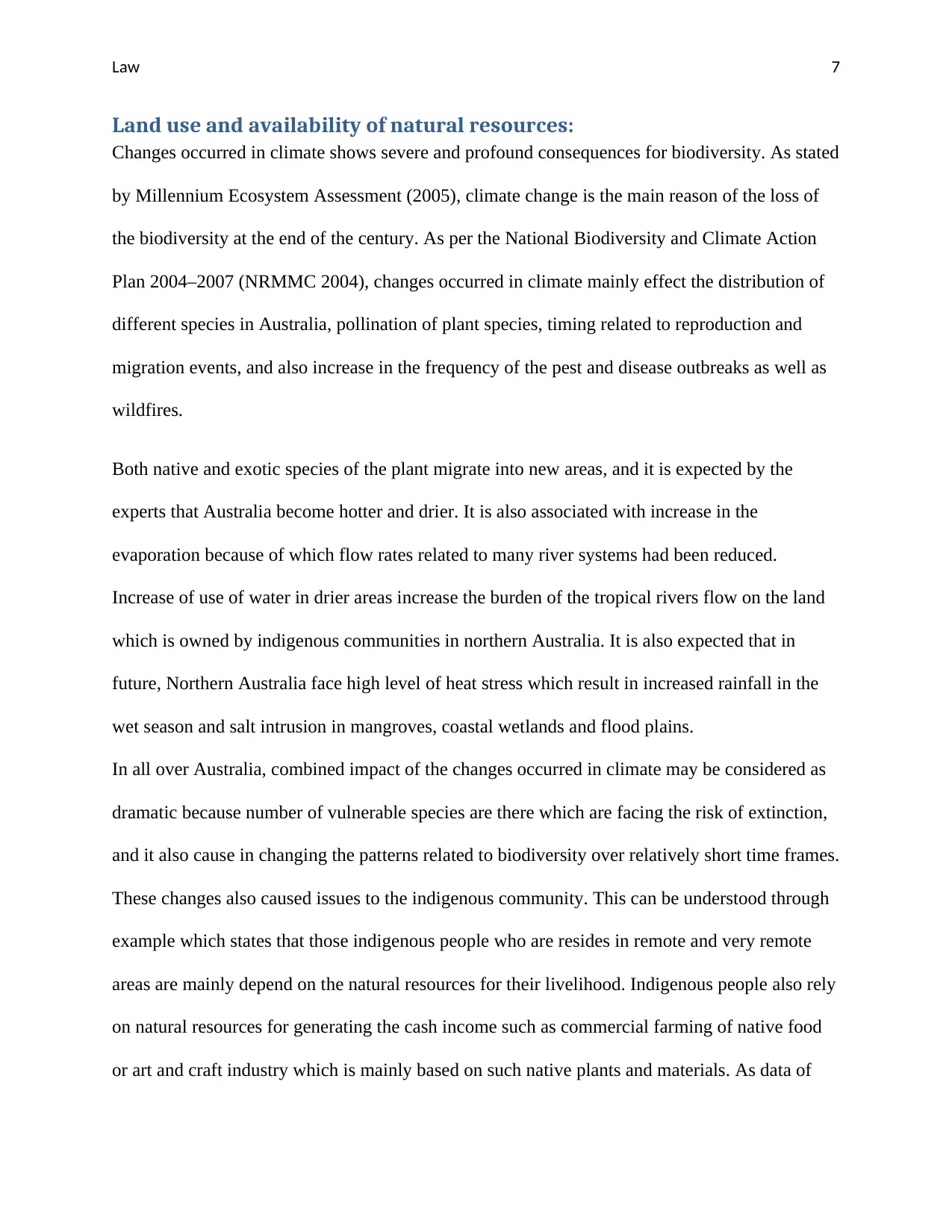
Law 7
Land use and availability of natural resources:
Changes occurred in climate shows severe and profound consequences for biodiversity. As stated
by Millennium Ecosystem Assessment (2005), climate change is the main reason of the loss of
the biodiversity at the end of the century. As per the National Biodiversity and Climate Action
Plan 2004–2007 (NRMMC 2004), changes occurred in climate mainly effect the distribution of
different species in Australia, pollination of plant species, timing related to reproduction and
migration events, and also increase in the frequency of the pest and disease outbreaks as well as
wildfires.
Both native and exotic species of the plant migrate into new areas, and it is expected by the
experts that Australia become hotter and drier. It is also associated with increase in the
evaporation because of which flow rates related to many river systems had been reduced.
Increase of use of water in drier areas increase the burden of the tropical rivers flow on the land
which is owned by indigenous communities in northern Australia. It is also expected that in
future, Northern Australia face high level of heat stress which result in increased rainfall in the
wet season and salt intrusion in mangroves, coastal wetlands and flood plains.
In all over Australia, combined impact of the changes occurred in climate may be considered as
dramatic because number of vulnerable species are there which are facing the risk of extinction,
and it also cause in changing the patterns related to biodiversity over relatively short time frames.
These changes also caused issues to the indigenous community. This can be understood through
example which states that those indigenous people who are resides in remote and very remote
areas are mainly depend on the natural resources for their livelihood. Indigenous people also rely
on natural resources for generating the cash income such as commercial farming of native food
or art and craft industry which is mainly based on such native plants and materials. As data of
Land use and availability of natural resources:
Changes occurred in climate shows severe and profound consequences for biodiversity. As stated
by Millennium Ecosystem Assessment (2005), climate change is the main reason of the loss of
the biodiversity at the end of the century. As per the National Biodiversity and Climate Action
Plan 2004–2007 (NRMMC 2004), changes occurred in climate mainly effect the distribution of
different species in Australia, pollination of plant species, timing related to reproduction and
migration events, and also increase in the frequency of the pest and disease outbreaks as well as
wildfires.
Both native and exotic species of the plant migrate into new areas, and it is expected by the
experts that Australia become hotter and drier. It is also associated with increase in the
evaporation because of which flow rates related to many river systems had been reduced.
Increase of use of water in drier areas increase the burden of the tropical rivers flow on the land
which is owned by indigenous communities in northern Australia. It is also expected that in
future, Northern Australia face high level of heat stress which result in increased rainfall in the
wet season and salt intrusion in mangroves, coastal wetlands and flood plains.
In all over Australia, combined impact of the changes occurred in climate may be considered as
dramatic because number of vulnerable species are there which are facing the risk of extinction,
and it also cause in changing the patterns related to biodiversity over relatively short time frames.
These changes also caused issues to the indigenous community. This can be understood through
example which states that those indigenous people who are resides in remote and very remote
areas are mainly depend on the natural resources for their livelihood. Indigenous people also rely
on natural resources for generating the cash income such as commercial farming of native food
or art and craft industry which is mainly based on such native plants and materials. As data of
Paraphrase This Document
Need a fresh take? Get an instant paraphrase of this document with our AI Paraphraser
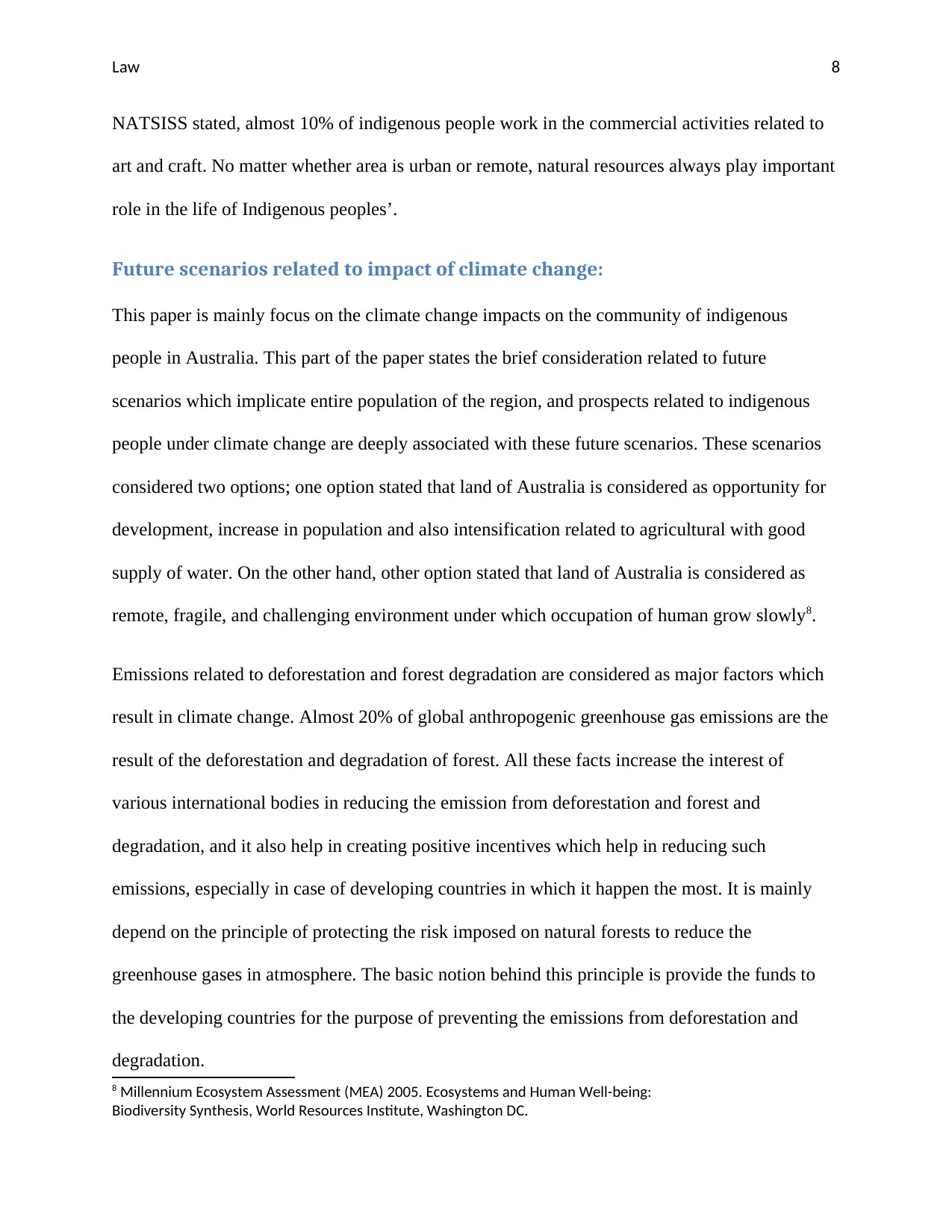
Law 8
NATSISS stated, almost 10% of indigenous people work in the commercial activities related to
art and craft. No matter whether area is urban or remote, natural resources always play important
role in the life of Indigenous peoples’.
Future scenarios related to impact of climate change:
This paper is mainly focus on the climate change impacts on the community of indigenous
people in Australia. This part of the paper states the brief consideration related to future
scenarios which implicate entire population of the region, and prospects related to indigenous
people under climate change are deeply associated with these future scenarios. These scenarios
considered two options; one option stated that land of Australia is considered as opportunity for
development, increase in population and also intensification related to agricultural with good
supply of water. On the other hand, other option stated that land of Australia is considered as
remote, fragile, and challenging environment under which occupation of human grow slowly8.
Emissions related to deforestation and forest degradation are considered as major factors which
result in climate change. Almost 20% of global anthropogenic greenhouse gas emissions are the
result of the deforestation and degradation of forest. All these facts increase the interest of
various international bodies in reducing the emission from deforestation and forest and
degradation, and it also help in creating positive incentives which help in reducing such
emissions, especially in case of developing countries in which it happen the most. It is mainly
depend on the principle of protecting the risk imposed on natural forests to reduce the
greenhouse gases in atmosphere. The basic notion behind this principle is provide the funds to
the developing countries for the purpose of preventing the emissions from deforestation and
degradation.
8 Millennium Ecosystem Assessment (MEA) 2005. Ecosystems and Human Well-being:
Biodiversity Synthesis, World Resources Institute, Washington DC.
NATSISS stated, almost 10% of indigenous people work in the commercial activities related to
art and craft. No matter whether area is urban or remote, natural resources always play important
role in the life of Indigenous peoples’.
Future scenarios related to impact of climate change:
This paper is mainly focus on the climate change impacts on the community of indigenous
people in Australia. This part of the paper states the brief consideration related to future
scenarios which implicate entire population of the region, and prospects related to indigenous
people under climate change are deeply associated with these future scenarios. These scenarios
considered two options; one option stated that land of Australia is considered as opportunity for
development, increase in population and also intensification related to agricultural with good
supply of water. On the other hand, other option stated that land of Australia is considered as
remote, fragile, and challenging environment under which occupation of human grow slowly8.
Emissions related to deforestation and forest degradation are considered as major factors which
result in climate change. Almost 20% of global anthropogenic greenhouse gas emissions are the
result of the deforestation and degradation of forest. All these facts increase the interest of
various international bodies in reducing the emission from deforestation and forest and
degradation, and it also help in creating positive incentives which help in reducing such
emissions, especially in case of developing countries in which it happen the most. It is mainly
depend on the principle of protecting the risk imposed on natural forests to reduce the
greenhouse gases in atmosphere. The basic notion behind this principle is provide the funds to
the developing countries for the purpose of preventing the emissions from deforestation and
degradation.
8 Millennium Ecosystem Assessment (MEA) 2005. Ecosystems and Human Well-being:
Biodiversity Synthesis, World Resources Institute, Washington DC.
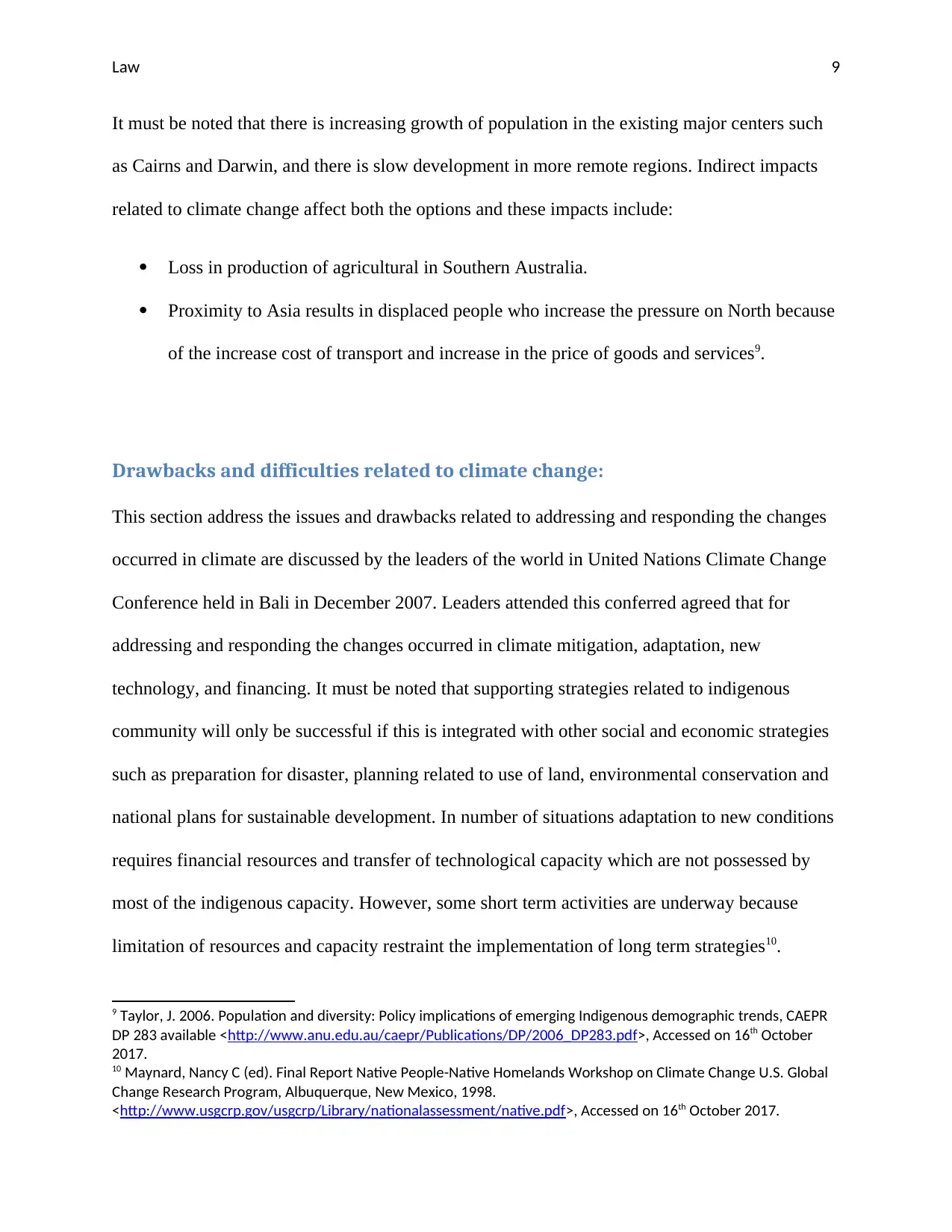
Law 9
It must be noted that there is increasing growth of population in the existing major centers such
as Cairns and Darwin, and there is slow development in more remote regions. Indirect impacts
related to climate change affect both the options and these impacts include:
Loss in production of agricultural in Southern Australia.
Proximity to Asia results in displaced people who increase the pressure on North because
of the increase cost of transport and increase in the price of goods and services9.
Drawbacks and difficulties related to climate change:
This section address the issues and drawbacks related to addressing and responding the changes
occurred in climate are discussed by the leaders of the world in United Nations Climate Change
Conference held in Bali in December 2007. Leaders attended this conferred agreed that for
addressing and responding the changes occurred in climate mitigation, adaptation, new
technology, and financing. It must be noted that supporting strategies related to indigenous
community will only be successful if this is integrated with other social and economic strategies
such as preparation for disaster, planning related to use of land, environmental conservation and
national plans for sustainable development. In number of situations adaptation to new conditions
requires financial resources and transfer of technological capacity which are not possessed by
most of the indigenous capacity. However, some short term activities are underway because
limitation of resources and capacity restraint the implementation of long term strategies10.
9 Taylor, J. 2006. Population and diversity: Policy implications of emerging Indigenous demographic trends, CAEPR
DP 283 available <http://www.anu.edu.au/caepr/Publications/DP/2006_DP283.pdf>, Accessed on 16th October
2017.
10 Maynard, Nancy C (ed). Final Report Native People-Native Homelands Workshop on Climate Change U.S. Global
Change Research Program, Albuquerque, New Mexico, 1998.
<http://www.usgcrp.gov/usgcrp/Library/nationalassessment/native.pdf>, Accessed on 16th October 2017.
It must be noted that there is increasing growth of population in the existing major centers such
as Cairns and Darwin, and there is slow development in more remote regions. Indirect impacts
related to climate change affect both the options and these impacts include:
Loss in production of agricultural in Southern Australia.
Proximity to Asia results in displaced people who increase the pressure on North because
of the increase cost of transport and increase in the price of goods and services9.
Drawbacks and difficulties related to climate change:
This section address the issues and drawbacks related to addressing and responding the changes
occurred in climate are discussed by the leaders of the world in United Nations Climate Change
Conference held in Bali in December 2007. Leaders attended this conferred agreed that for
addressing and responding the changes occurred in climate mitigation, adaptation, new
technology, and financing. It must be noted that supporting strategies related to indigenous
community will only be successful if this is integrated with other social and economic strategies
such as preparation for disaster, planning related to use of land, environmental conservation and
national plans for sustainable development. In number of situations adaptation to new conditions
requires financial resources and transfer of technological capacity which are not possessed by
most of the indigenous capacity. However, some short term activities are underway because
limitation of resources and capacity restraint the implementation of long term strategies10.
9 Taylor, J. 2006. Population and diversity: Policy implications of emerging Indigenous demographic trends, CAEPR
DP 283 available <http://www.anu.edu.au/caepr/Publications/DP/2006_DP283.pdf>, Accessed on 16th October
2017.
10 Maynard, Nancy C (ed). Final Report Native People-Native Homelands Workshop on Climate Change U.S. Global
Change Research Program, Albuquerque, New Mexico, 1998.
<http://www.usgcrp.gov/usgcrp/Library/nationalassessment/native.pdf>, Accessed on 16th October 2017.
You're viewing a preview
Unlock full access by subscribing today!
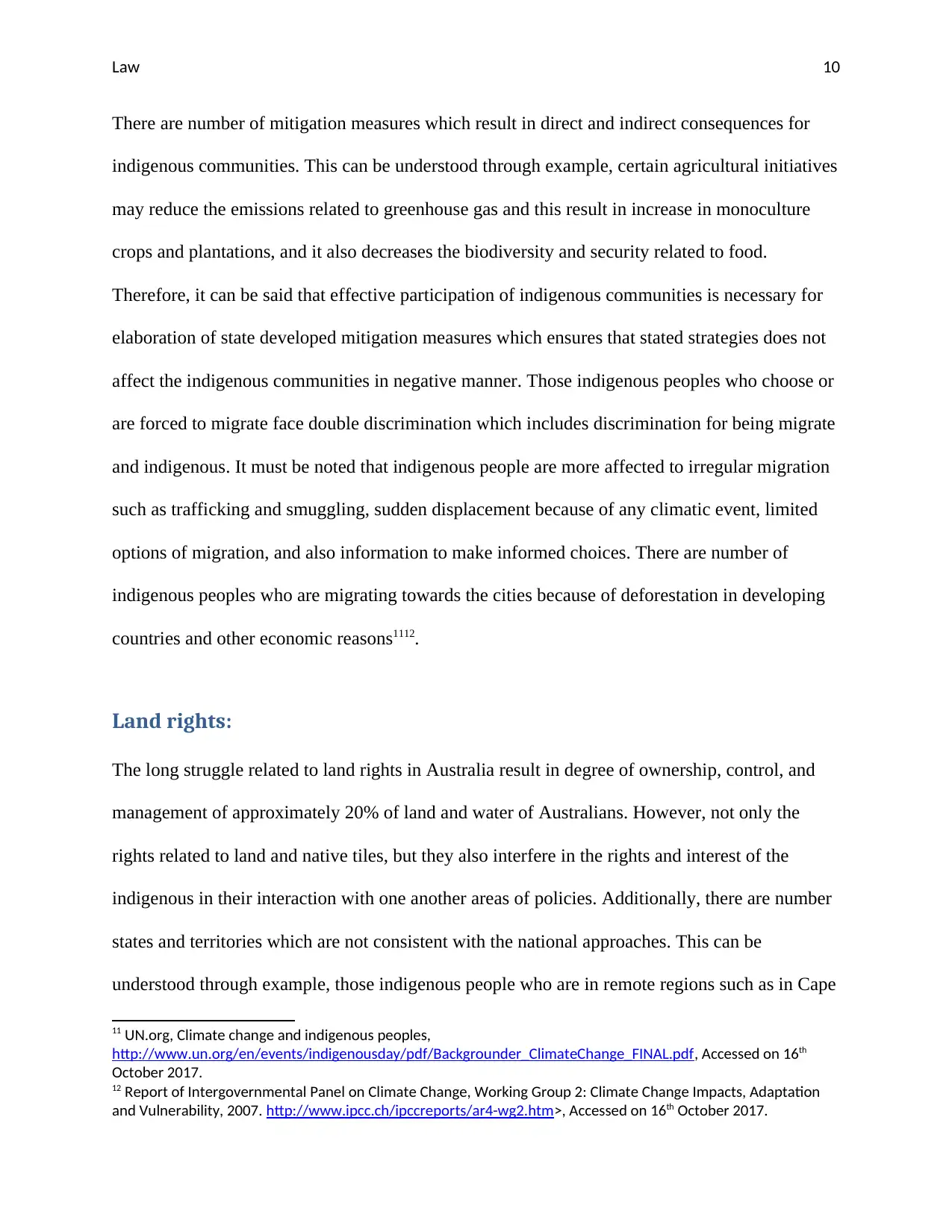
Law 10
There are number of mitigation measures which result in direct and indirect consequences for
indigenous communities. This can be understood through example, certain agricultural initiatives
may reduce the emissions related to greenhouse gas and this result in increase in monoculture
crops and plantations, and it also decreases the biodiversity and security related to food.
Therefore, it can be said that effective participation of indigenous communities is necessary for
elaboration of state developed mitigation measures which ensures that stated strategies does not
affect the indigenous communities in negative manner. Those indigenous peoples who choose or
are forced to migrate face double discrimination which includes discrimination for being migrate
and indigenous. It must be noted that indigenous people are more affected to irregular migration
such as trafficking and smuggling, sudden displacement because of any climatic event, limited
options of migration, and also information to make informed choices. There are number of
indigenous peoples who are migrating towards the cities because of deforestation in developing
countries and other economic reasons1112.
Land rights:
The long struggle related to land rights in Australia result in degree of ownership, control, and
management of approximately 20% of land and water of Australians. However, not only the
rights related to land and native tiles, but they also interfere in the rights and interest of the
indigenous in their interaction with one another areas of policies. Additionally, there are number
states and territories which are not consistent with the national approaches. This can be
understood through example, those indigenous people who are in remote regions such as in Cape
11 UN.org, Climate change and indigenous peoples,
http://www.un.org/en/events/indigenousday/pdf/Backgrounder_ClimateChange_FINAL.pdf, Accessed on 16th
October 2017.
12 Report of Intergovernmental Panel on Climate Change, Working Group 2: Climate Change Impacts, Adaptation
and Vulnerability, 2007. http://www.ipcc.ch/ipccreports/ar4-wg2.htm>, Accessed on 16th October 2017.
There are number of mitigation measures which result in direct and indirect consequences for
indigenous communities. This can be understood through example, certain agricultural initiatives
may reduce the emissions related to greenhouse gas and this result in increase in monoculture
crops and plantations, and it also decreases the biodiversity and security related to food.
Therefore, it can be said that effective participation of indigenous communities is necessary for
elaboration of state developed mitigation measures which ensures that stated strategies does not
affect the indigenous communities in negative manner. Those indigenous peoples who choose or
are forced to migrate face double discrimination which includes discrimination for being migrate
and indigenous. It must be noted that indigenous people are more affected to irregular migration
such as trafficking and smuggling, sudden displacement because of any climatic event, limited
options of migration, and also information to make informed choices. There are number of
indigenous peoples who are migrating towards the cities because of deforestation in developing
countries and other economic reasons1112.
Land rights:
The long struggle related to land rights in Australia result in degree of ownership, control, and
management of approximately 20% of land and water of Australians. However, not only the
rights related to land and native tiles, but they also interfere in the rights and interest of the
indigenous in their interaction with one another areas of policies. Additionally, there are number
states and territories which are not consistent with the national approaches. This can be
understood through example, those indigenous people who are in remote regions such as in Cape
11 UN.org, Climate change and indigenous peoples,
http://www.un.org/en/events/indigenousday/pdf/Backgrounder_ClimateChange_FINAL.pdf, Accessed on 16th
October 2017.
12 Report of Intergovernmental Panel on Climate Change, Working Group 2: Climate Change Impacts, Adaptation
and Vulnerability, 2007. http://www.ipcc.ch/ipccreports/ar4-wg2.htm>, Accessed on 16th October 2017.
Paraphrase This Document
Need a fresh take? Get an instant paraphrase of this document with our AI Paraphraser
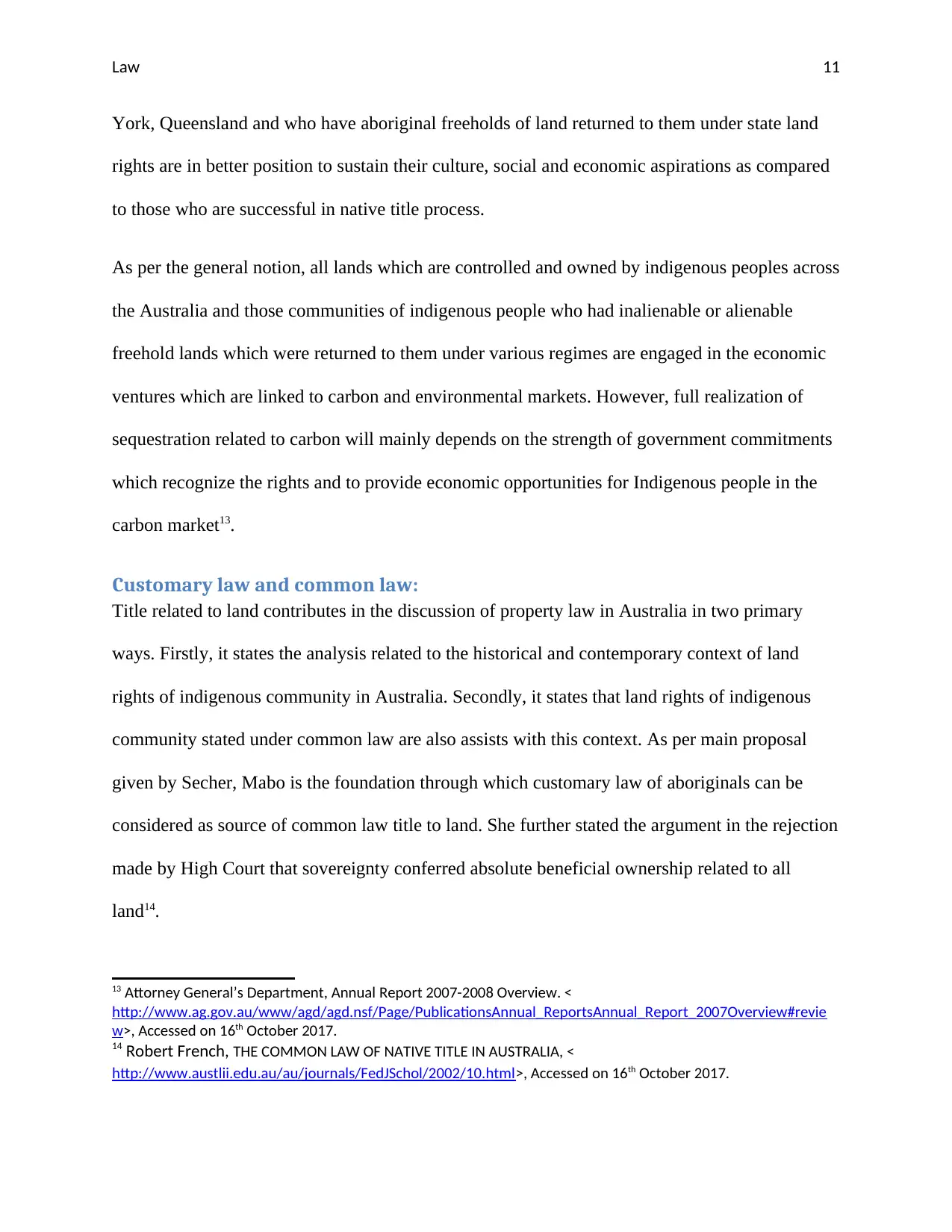
Law 11
York, Queensland and who have aboriginal freeholds of land returned to them under state land
rights are in better position to sustain their culture, social and economic aspirations as compared
to those who are successful in native title process.
As per the general notion, all lands which are controlled and owned by indigenous peoples across
the Australia and those communities of indigenous people who had inalienable or alienable
freehold lands which were returned to them under various regimes are engaged in the economic
ventures which are linked to carbon and environmental markets. However, full realization of
sequestration related to carbon will mainly depends on the strength of government commitments
which recognize the rights and to provide economic opportunities for Indigenous people in the
carbon market13.
Customary law and common law:
Title related to land contributes in the discussion of property law in Australia in two primary
ways. Firstly, it states the analysis related to the historical and contemporary context of land
rights of indigenous community in Australia. Secondly, it states that land rights of indigenous
community stated under common law are also assists with this context. As per main proposal
given by Secher, Mabo is the foundation through which customary law of aboriginals can be
considered as source of common law title to land. She further stated the argument in the rejection
made by High Court that sovereignty conferred absolute beneficial ownership related to all
land14.
13 Attorney General’s Department, Annual Report 2007-2008 Overview. <
http://www.ag.gov.au/www/agd/agd.nsf/Page/PublicationsAnnual_ReportsAnnual_Report_2007Overview#revie
w>, Accessed on 16th October 2017.
14 Robert French, THE COMMON LAW OF NATIVE TITLE IN AUSTRALIA, <
http://www.austlii.edu.au/au/journals/FedJSchol/2002/10.html>, Accessed on 16th October 2017.
York, Queensland and who have aboriginal freeholds of land returned to them under state land
rights are in better position to sustain their culture, social and economic aspirations as compared
to those who are successful in native title process.
As per the general notion, all lands which are controlled and owned by indigenous peoples across
the Australia and those communities of indigenous people who had inalienable or alienable
freehold lands which were returned to them under various regimes are engaged in the economic
ventures which are linked to carbon and environmental markets. However, full realization of
sequestration related to carbon will mainly depends on the strength of government commitments
which recognize the rights and to provide economic opportunities for Indigenous people in the
carbon market13.
Customary law and common law:
Title related to land contributes in the discussion of property law in Australia in two primary
ways. Firstly, it states the analysis related to the historical and contemporary context of land
rights of indigenous community in Australia. Secondly, it states that land rights of indigenous
community stated under common law are also assists with this context. As per main proposal
given by Secher, Mabo is the foundation through which customary law of aboriginals can be
considered as source of common law title to land. She further stated the argument in the rejection
made by High Court that sovereignty conferred absolute beneficial ownership related to all
land14.
13 Attorney General’s Department, Annual Report 2007-2008 Overview. <
http://www.ag.gov.au/www/agd/agd.nsf/Page/PublicationsAnnual_ReportsAnnual_Report_2007Overview#revie
w>, Accessed on 16th October 2017.
14 Robert French, THE COMMON LAW OF NATIVE TITLE IN AUSTRALIA, <
http://www.austlii.edu.au/au/journals/FedJSchol/2002/10.html>, Accessed on 16th October 2017.
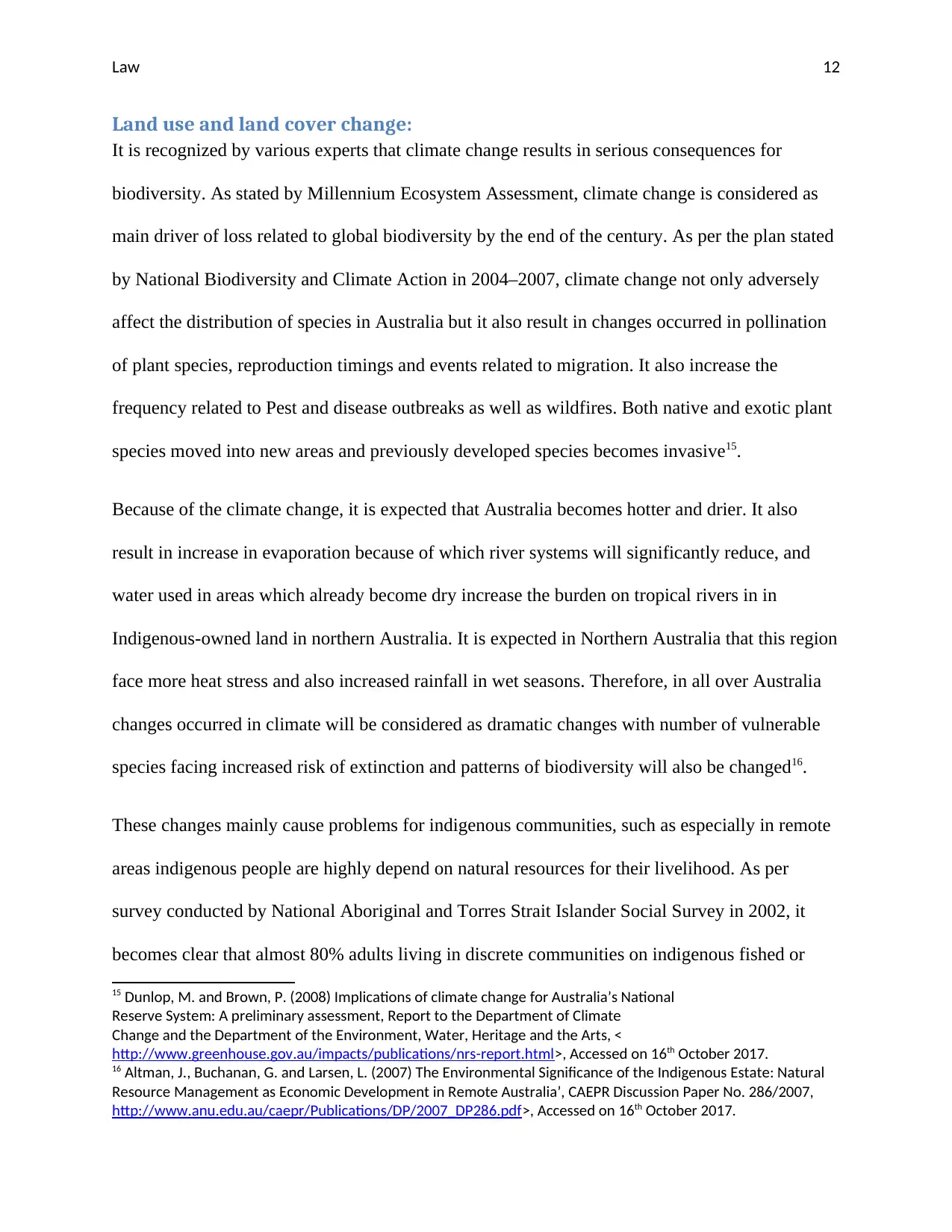
Law 12
Land use and land cover change:
It is recognized by various experts that climate change results in serious consequences for
biodiversity. As stated by Millennium Ecosystem Assessment, climate change is considered as
main driver of loss related to global biodiversity by the end of the century. As per the plan stated
by National Biodiversity and Climate Action in 2004–2007, climate change not only adversely
affect the distribution of species in Australia but it also result in changes occurred in pollination
of plant species, reproduction timings and events related to migration. It also increase the
frequency related to Pest and disease outbreaks as well as wildfires. Both native and exotic plant
species moved into new areas and previously developed species becomes invasive15.
Because of the climate change, it is expected that Australia becomes hotter and drier. It also
result in increase in evaporation because of which river systems will significantly reduce, and
water used in areas which already become dry increase the burden on tropical rivers in in
Indigenous-owned land in northern Australia. It is expected in Northern Australia that this region
face more heat stress and also increased rainfall in wet seasons. Therefore, in all over Australia
changes occurred in climate will be considered as dramatic changes with number of vulnerable
species facing increased risk of extinction and patterns of biodiversity will also be changed16.
These changes mainly cause problems for indigenous communities, such as especially in remote
areas indigenous people are highly depend on natural resources for their livelihood. As per
survey conducted by National Aboriginal and Torres Strait Islander Social Survey in 2002, it
becomes clear that almost 80% adults living in discrete communities on indigenous fished or
15 Dunlop, M. and Brown, P. (2008) Implications of climate change for Australia’s National
Reserve System: A preliminary assessment, Report to the Department of Climate
Change and the Department of the Environment, Water, Heritage and the Arts, <
http://www.greenhouse.gov.au/impacts/publications/nrs-report.html>, Accessed on 16th October 2017.
16 Altman, J., Buchanan, G. and Larsen, L. (2007) The Environmental Significance of the Indigenous Estate: Natural
Resource Management as Economic Development in Remote Australia’, CAEPR Discussion Paper No. 286/2007,
http://www.anu.edu.au/caepr/Publications/DP/2007_DP286.pdf>, Accessed on 16th October 2017.
Land use and land cover change:
It is recognized by various experts that climate change results in serious consequences for
biodiversity. As stated by Millennium Ecosystem Assessment, climate change is considered as
main driver of loss related to global biodiversity by the end of the century. As per the plan stated
by National Biodiversity and Climate Action in 2004–2007, climate change not only adversely
affect the distribution of species in Australia but it also result in changes occurred in pollination
of plant species, reproduction timings and events related to migration. It also increase the
frequency related to Pest and disease outbreaks as well as wildfires. Both native and exotic plant
species moved into new areas and previously developed species becomes invasive15.
Because of the climate change, it is expected that Australia becomes hotter and drier. It also
result in increase in evaporation because of which river systems will significantly reduce, and
water used in areas which already become dry increase the burden on tropical rivers in in
Indigenous-owned land in northern Australia. It is expected in Northern Australia that this region
face more heat stress and also increased rainfall in wet seasons. Therefore, in all over Australia
changes occurred in climate will be considered as dramatic changes with number of vulnerable
species facing increased risk of extinction and patterns of biodiversity will also be changed16.
These changes mainly cause problems for indigenous communities, such as especially in remote
areas indigenous people are highly depend on natural resources for their livelihood. As per
survey conducted by National Aboriginal and Torres Strait Islander Social Survey in 2002, it
becomes clear that almost 80% adults living in discrete communities on indigenous fished or
15 Dunlop, M. and Brown, P. (2008) Implications of climate change for Australia’s National
Reserve System: A preliminary assessment, Report to the Department of Climate
Change and the Department of the Environment, Water, Heritage and the Arts, <
http://www.greenhouse.gov.au/impacts/publications/nrs-report.html>, Accessed on 16th October 2017.
16 Altman, J., Buchanan, G. and Larsen, L. (2007) The Environmental Significance of the Indigenous Estate: Natural
Resource Management as Economic Development in Remote Australia’, CAEPR Discussion Paper No. 286/2007,
http://www.anu.edu.au/caepr/Publications/DP/2007_DP286.pdf>, Accessed on 16th October 2017.
You're viewing a preview
Unlock full access by subscribing today!
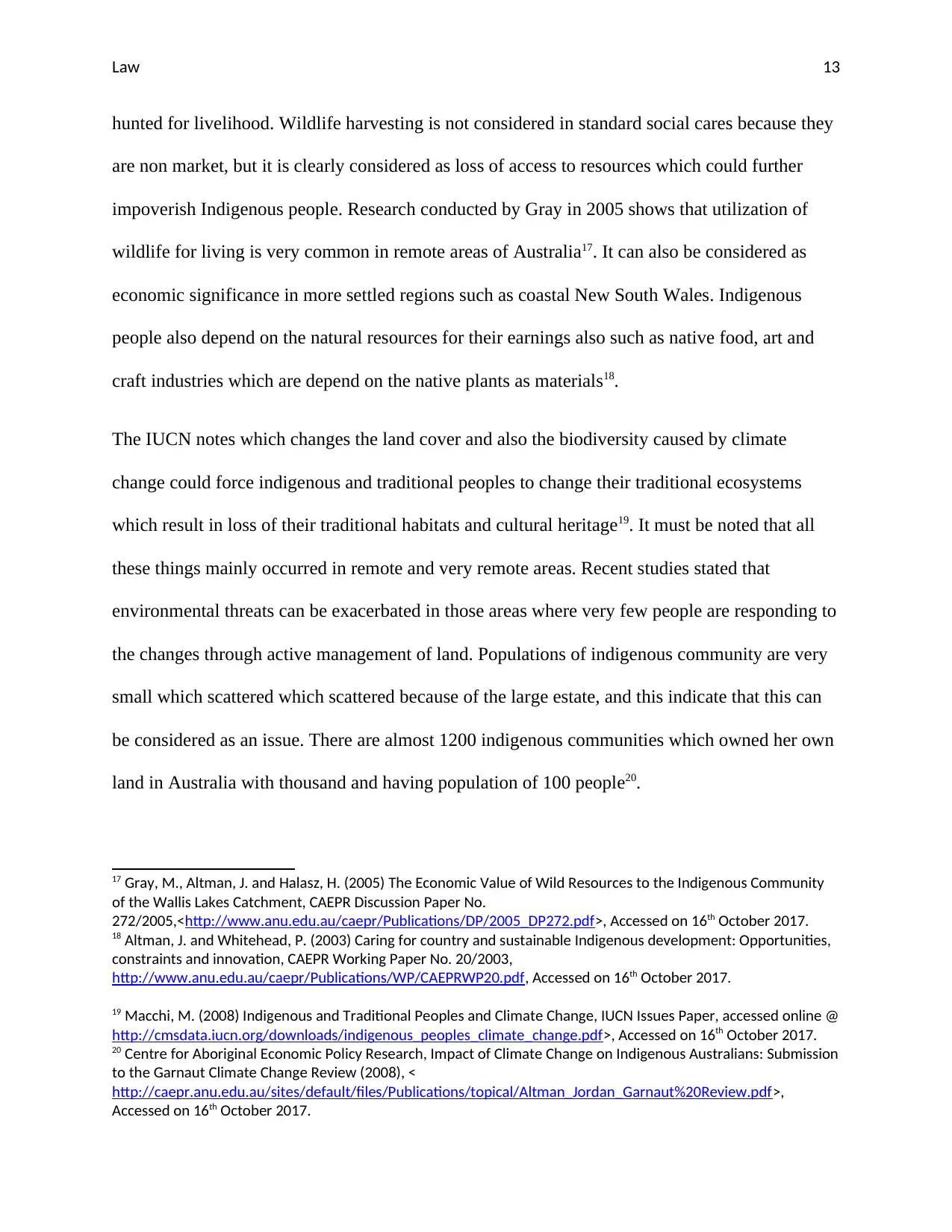
Law 13
hunted for livelihood. Wildlife harvesting is not considered in standard social cares because they
are non market, but it is clearly considered as loss of access to resources which could further
impoverish Indigenous people. Research conducted by Gray in 2005 shows that utilization of
wildlife for living is very common in remote areas of Australia17. It can also be considered as
economic significance in more settled regions such as coastal New South Wales. Indigenous
people also depend on the natural resources for their earnings also such as native food, art and
craft industries which are depend on the native plants as materials18.
The IUCN notes which changes the land cover and also the biodiversity caused by climate
change could force indigenous and traditional peoples to change their traditional ecosystems
which result in loss of their traditional habitats and cultural heritage19. It must be noted that all
these things mainly occurred in remote and very remote areas. Recent studies stated that
environmental threats can be exacerbated in those areas where very few people are responding to
the changes through active management of land. Populations of indigenous community are very
small which scattered which scattered because of the large estate, and this indicate that this can
be considered as an issue. There are almost 1200 indigenous communities which owned her own
land in Australia with thousand and having population of 100 people20.
17 Gray, M., Altman, J. and Halasz, H. (2005) The Economic Value of Wild Resources to the Indigenous Community
of the Wallis Lakes Catchment, CAEPR Discussion Paper No.
272/2005,<http://www.anu.edu.au/caepr/Publications/DP/2005_DP272.pdf>, Accessed on 16th October 2017.
18 Altman, J. and Whitehead, P. (2003) Caring for country and sustainable Indigenous development: Opportunities,
constraints and innovation, CAEPR Working Paper No. 20/2003,
http://www.anu.edu.au/caepr/Publications/WP/CAEPRWP20.pdf, Accessed on 16th October 2017.
19 Macchi, M. (2008) Indigenous and Traditional Peoples and Climate Change, IUCN Issues Paper, accessed online @
http://cmsdata.iucn.org/downloads/indigenous_peoples_climate_change.pdf>, Accessed on 16th October 2017.
20 Centre for Aboriginal Economic Policy Research, Impact of Climate Change on Indigenous Australians: Submission
to the Garnaut Climate Change Review (2008), <
http://caepr.anu.edu.au/sites/default/files/Publications/topical/Altman_Jordan_Garnaut%20Review.pdf>,
Accessed on 16th October 2017.
hunted for livelihood. Wildlife harvesting is not considered in standard social cares because they
are non market, but it is clearly considered as loss of access to resources which could further
impoverish Indigenous people. Research conducted by Gray in 2005 shows that utilization of
wildlife for living is very common in remote areas of Australia17. It can also be considered as
economic significance in more settled regions such as coastal New South Wales. Indigenous
people also depend on the natural resources for their earnings also such as native food, art and
craft industries which are depend on the native plants as materials18.
The IUCN notes which changes the land cover and also the biodiversity caused by climate
change could force indigenous and traditional peoples to change their traditional ecosystems
which result in loss of their traditional habitats and cultural heritage19. It must be noted that all
these things mainly occurred in remote and very remote areas. Recent studies stated that
environmental threats can be exacerbated in those areas where very few people are responding to
the changes through active management of land. Populations of indigenous community are very
small which scattered which scattered because of the large estate, and this indicate that this can
be considered as an issue. There are almost 1200 indigenous communities which owned her own
land in Australia with thousand and having population of 100 people20.
17 Gray, M., Altman, J. and Halasz, H. (2005) The Economic Value of Wild Resources to the Indigenous Community
of the Wallis Lakes Catchment, CAEPR Discussion Paper No.
272/2005,<http://www.anu.edu.au/caepr/Publications/DP/2005_DP272.pdf>, Accessed on 16th October 2017.
18 Altman, J. and Whitehead, P. (2003) Caring for country and sustainable Indigenous development: Opportunities,
constraints and innovation, CAEPR Working Paper No. 20/2003,
http://www.anu.edu.au/caepr/Publications/WP/CAEPRWP20.pdf, Accessed on 16th October 2017.
19 Macchi, M. (2008) Indigenous and Traditional Peoples and Climate Change, IUCN Issues Paper, accessed online @
http://cmsdata.iucn.org/downloads/indigenous_peoples_climate_change.pdf>, Accessed on 16th October 2017.
20 Centre for Aboriginal Economic Policy Research, Impact of Climate Change on Indigenous Australians: Submission
to the Garnaut Climate Change Review (2008), <
http://caepr.anu.edu.au/sites/default/files/Publications/topical/Altman_Jordan_Garnaut%20Review.pdf>,
Accessed on 16th October 2017.
Paraphrase This Document
Need a fresh take? Get an instant paraphrase of this document with our AI Paraphraser
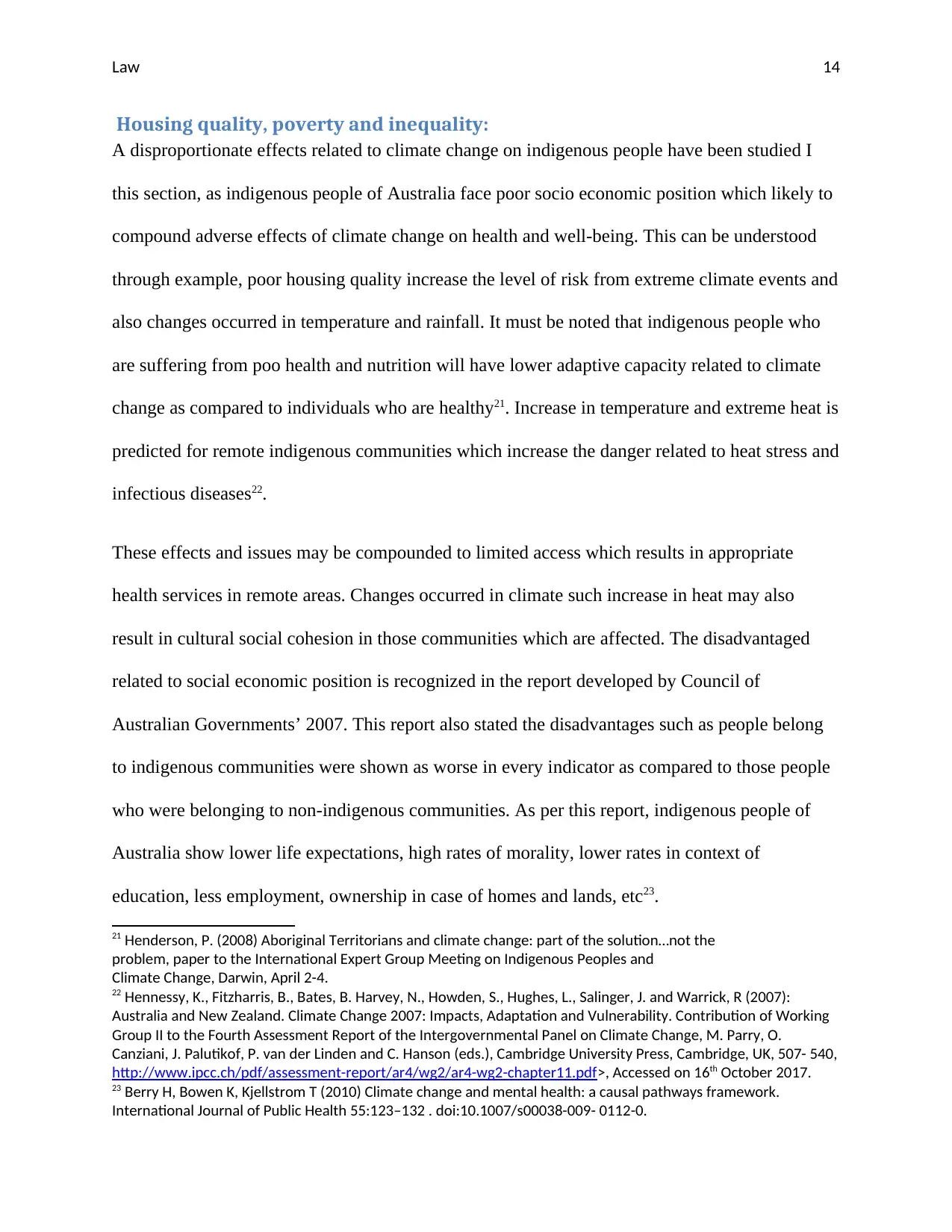
Law 14
Housing quality, poverty and inequality:
A disproportionate effects related to climate change on indigenous people have been studied I
this section, as indigenous people of Australia face poor socio economic position which likely to
compound adverse effects of climate change on health and well-being. This can be understood
through example, poor housing quality increase the level of risk from extreme climate events and
also changes occurred in temperature and rainfall. It must be noted that indigenous people who
are suffering from poo health and nutrition will have lower adaptive capacity related to climate
change as compared to individuals who are healthy21. Increase in temperature and extreme heat is
predicted for remote indigenous communities which increase the danger related to heat stress and
infectious diseases22.
These effects and issues may be compounded to limited access which results in appropriate
health services in remote areas. Changes occurred in climate such increase in heat may also
result in cultural social cohesion in those communities which are affected. The disadvantaged
related to social economic position is recognized in the report developed by Council of
Australian Governments’ 2007. This report also stated the disadvantages such as people belong
to indigenous communities were shown as worse in every indicator as compared to those people
who were belonging to non-indigenous communities. As per this report, indigenous people of
Australia show lower life expectations, high rates of morality, lower rates in context of
education, less employment, ownership in case of homes and lands, etc23.
21 Henderson, P. (2008) Aboriginal Territorians and climate change: part of the solution…not the
problem, paper to the International Expert Group Meeting on Indigenous Peoples and
Climate Change, Darwin, April 2-4.
22 Hennessy, K., Fitzharris, B., Bates, B. Harvey, N., Howden, S., Hughes, L., Salinger, J. and Warrick, R (2007):
Australia and New Zealand. Climate Change 2007: Impacts, Adaptation and Vulnerability. Contribution of Working
Group II to the Fourth Assessment Report of the Intergovernmental Panel on Climate Change, M. Parry, O.
Canziani, J. Palutikof, P. van der Linden and C. Hanson (eds.), Cambridge University Press, Cambridge, UK, 507- 540,
http://www.ipcc.ch/pdf/assessment-report/ar4/wg2/ar4-wg2-chapter11.pdf>, Accessed on 16th October 2017.
23 Berry H, Bowen K, Kjellstrom T (2010) Climate change and mental health: a causal pathways framework.
International Journal of Public Health 55:123–132 . doi:10.1007/s00038-009- 0112-0.
Housing quality, poverty and inequality:
A disproportionate effects related to climate change on indigenous people have been studied I
this section, as indigenous people of Australia face poor socio economic position which likely to
compound adverse effects of climate change on health and well-being. This can be understood
through example, poor housing quality increase the level of risk from extreme climate events and
also changes occurred in temperature and rainfall. It must be noted that indigenous people who
are suffering from poo health and nutrition will have lower adaptive capacity related to climate
change as compared to individuals who are healthy21. Increase in temperature and extreme heat is
predicted for remote indigenous communities which increase the danger related to heat stress and
infectious diseases22.
These effects and issues may be compounded to limited access which results in appropriate
health services in remote areas. Changes occurred in climate such increase in heat may also
result in cultural social cohesion in those communities which are affected. The disadvantaged
related to social economic position is recognized in the report developed by Council of
Australian Governments’ 2007. This report also stated the disadvantages such as people belong
to indigenous communities were shown as worse in every indicator as compared to those people
who were belonging to non-indigenous communities. As per this report, indigenous people of
Australia show lower life expectations, high rates of morality, lower rates in context of
education, less employment, ownership in case of homes and lands, etc23.
21 Henderson, P. (2008) Aboriginal Territorians and climate change: part of the solution…not the
problem, paper to the International Expert Group Meeting on Indigenous Peoples and
Climate Change, Darwin, April 2-4.
22 Hennessy, K., Fitzharris, B., Bates, B. Harvey, N., Howden, S., Hughes, L., Salinger, J. and Warrick, R (2007):
Australia and New Zealand. Climate Change 2007: Impacts, Adaptation and Vulnerability. Contribution of Working
Group II to the Fourth Assessment Report of the Intergovernmental Panel on Climate Change, M. Parry, O.
Canziani, J. Palutikof, P. van der Linden and C. Hanson (eds.), Cambridge University Press, Cambridge, UK, 507- 540,
http://www.ipcc.ch/pdf/assessment-report/ar4/wg2/ar4-wg2-chapter11.pdf>, Accessed on 16th October 2017.
23 Berry H, Bowen K, Kjellstrom T (2010) Climate change and mental health: a causal pathways framework.
International Journal of Public Health 55:123–132 . doi:10.1007/s00038-009- 0112-0.
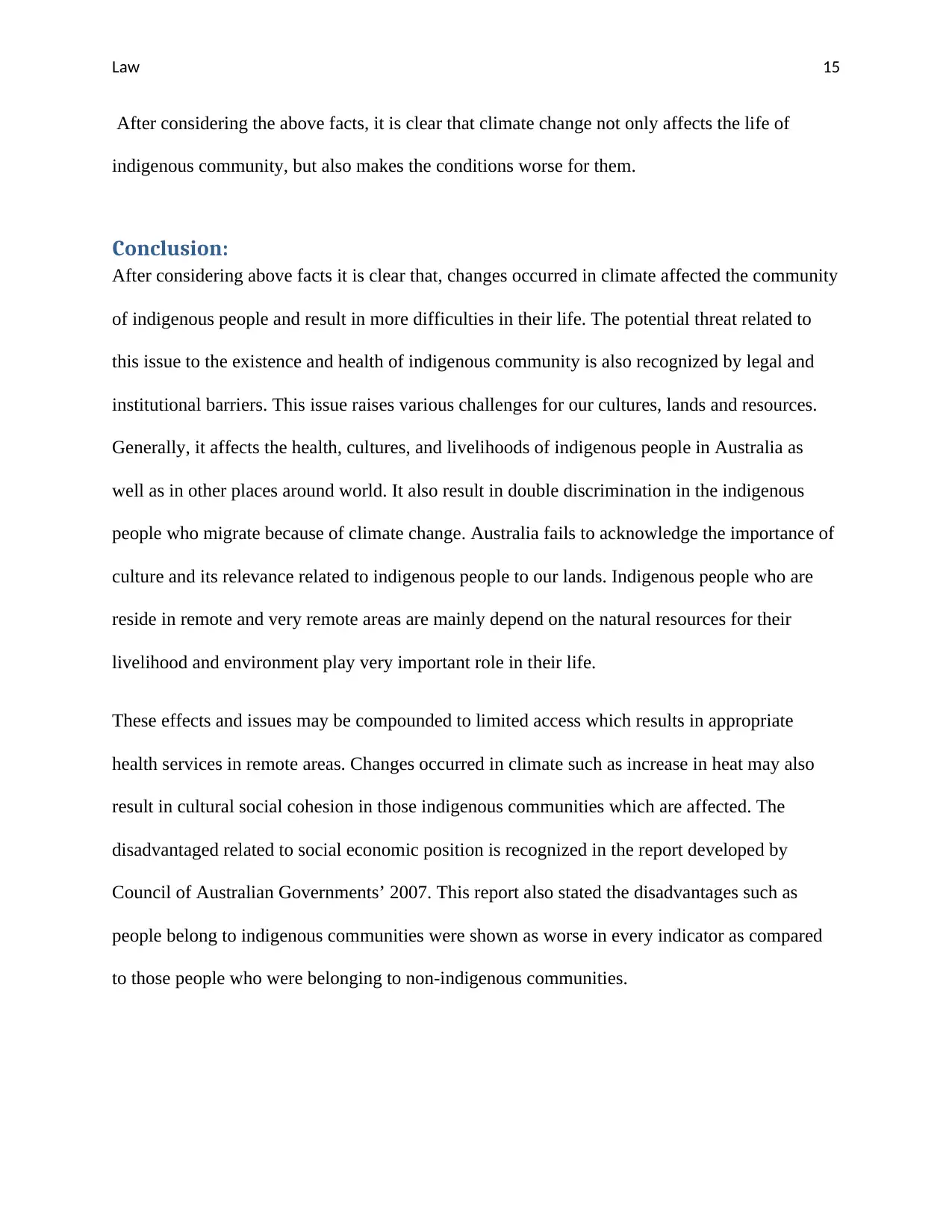
Law 15
After considering the above facts, it is clear that climate change not only affects the life of
indigenous community, but also makes the conditions worse for them.
Conclusion:
After considering above facts it is clear that, changes occurred in climate affected the community
of indigenous people and result in more difficulties in their life. The potential threat related to
this issue to the existence and health of indigenous community is also recognized by legal and
institutional barriers. This issue raises various challenges for our cultures, lands and resources.
Generally, it affects the health, cultures, and livelihoods of indigenous people in Australia as
well as in other places around world. It also result in double discrimination in the indigenous
people who migrate because of climate change. Australia fails to acknowledge the importance of
culture and its relevance related to indigenous people to our lands. Indigenous people who are
reside in remote and very remote areas are mainly depend on the natural resources for their
livelihood and environment play very important role in their life.
These effects and issues may be compounded to limited access which results in appropriate
health services in remote areas. Changes occurred in climate such as increase in heat may also
result in cultural social cohesion in those indigenous communities which are affected. The
disadvantaged related to social economic position is recognized in the report developed by
Council of Australian Governments’ 2007. This report also stated the disadvantages such as
people belong to indigenous communities were shown as worse in every indicator as compared
to those people who were belonging to non-indigenous communities.
After considering the above facts, it is clear that climate change not only affects the life of
indigenous community, but also makes the conditions worse for them.
Conclusion:
After considering above facts it is clear that, changes occurred in climate affected the community
of indigenous people and result in more difficulties in their life. The potential threat related to
this issue to the existence and health of indigenous community is also recognized by legal and
institutional barriers. This issue raises various challenges for our cultures, lands and resources.
Generally, it affects the health, cultures, and livelihoods of indigenous people in Australia as
well as in other places around world. It also result in double discrimination in the indigenous
people who migrate because of climate change. Australia fails to acknowledge the importance of
culture and its relevance related to indigenous people to our lands. Indigenous people who are
reside in remote and very remote areas are mainly depend on the natural resources for their
livelihood and environment play very important role in their life.
These effects and issues may be compounded to limited access which results in appropriate
health services in remote areas. Changes occurred in climate such as increase in heat may also
result in cultural social cohesion in those indigenous communities which are affected. The
disadvantaged related to social economic position is recognized in the report developed by
Council of Australian Governments’ 2007. This report also stated the disadvantages such as
people belong to indigenous communities were shown as worse in every indicator as compared
to those people who were belonging to non-indigenous communities.
You're viewing a preview
Unlock full access by subscribing today!
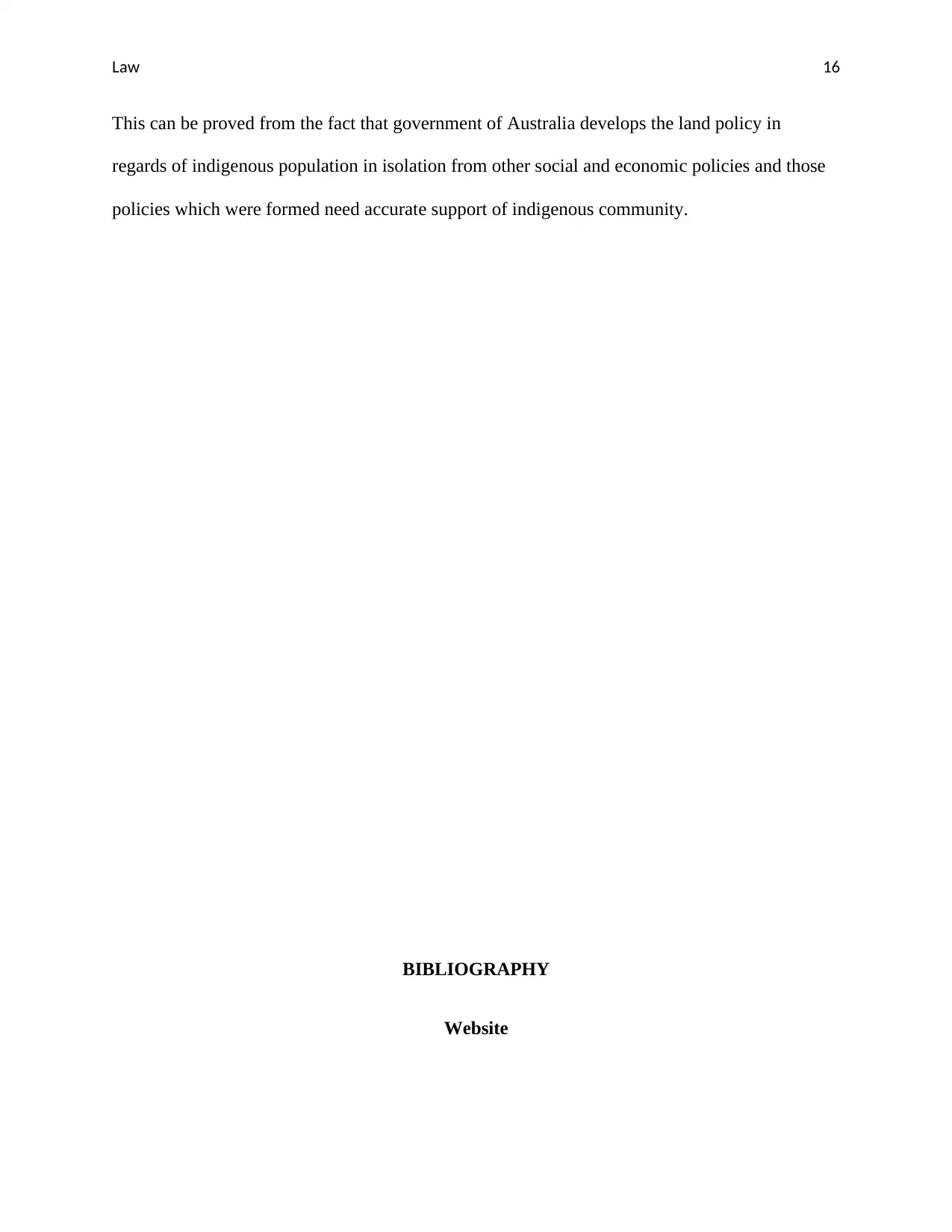
Law 16
This can be proved from the fact that government of Australia develops the land policy in
regards of indigenous population in isolation from other social and economic policies and those
policies which were formed need accurate support of indigenous community.
BIBLIOGRAPHY
Website
This can be proved from the fact that government of Australia develops the land policy in
regards of indigenous population in isolation from other social and economic policies and those
policies which were formed need accurate support of indigenous community.
BIBLIOGRAPHY
Website
Paraphrase This Document
Need a fresh take? Get an instant paraphrase of this document with our AI Paraphraser
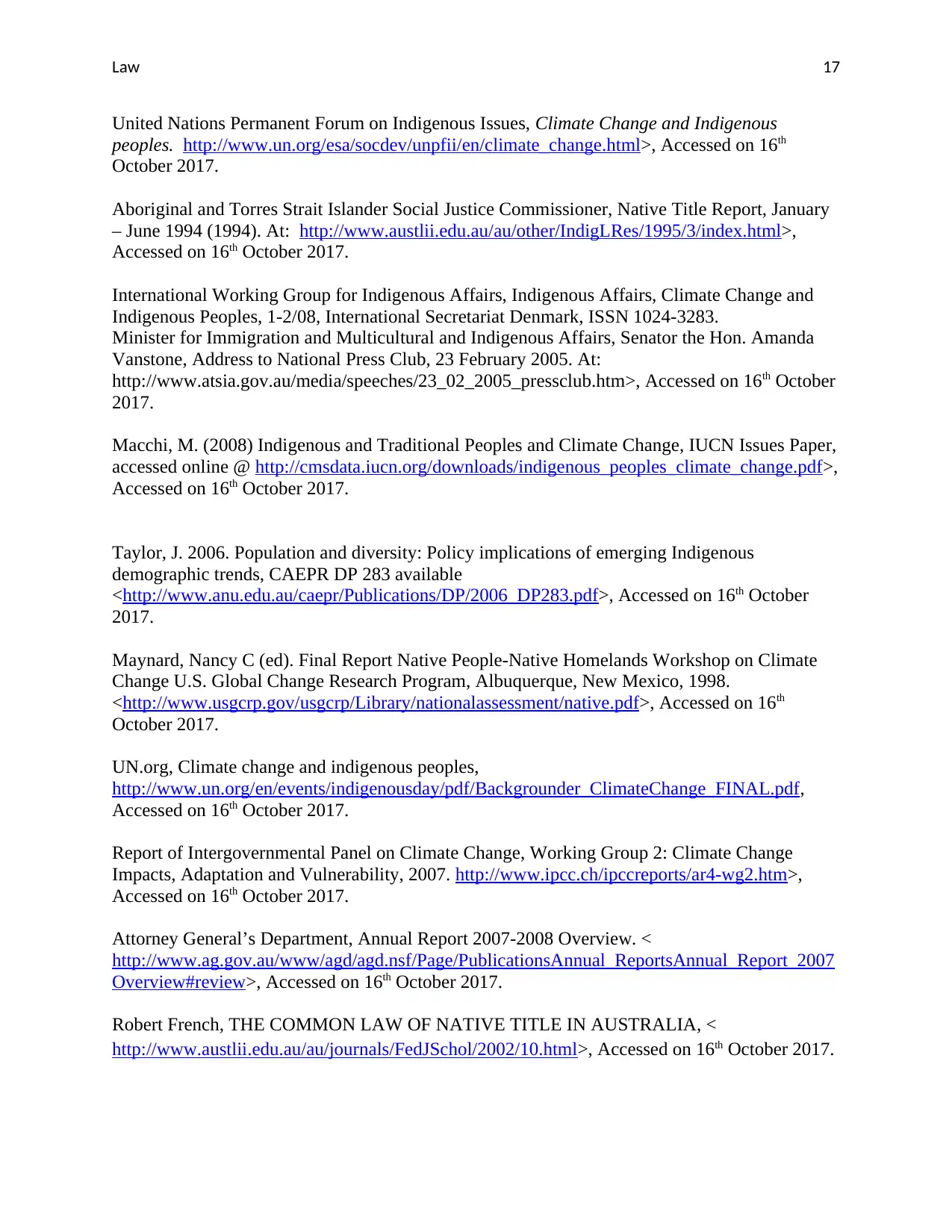
Law 17
United Nations Permanent Forum on Indigenous Issues, Climate Change and Indigenous
peoples. http://www.un.org/esa/socdev/unpfii/en/climate_change.html>, Accessed on 16th
October 2017.
Aboriginal and Torres Strait Islander Social Justice Commissioner, Native Title Report, January
– June 1994 (1994). At: http://www.austlii.edu.au/au/other/IndigLRes/1995/3/index.html>,
Accessed on 16th October 2017.
International Working Group for Indigenous Affairs, Indigenous Affairs, Climate Change and
Indigenous Peoples, 1-2/08, International Secretariat Denmark, ISSN 1024-3283.
Minister for Immigration and Multicultural and Indigenous Affairs, Senator the Hon. Amanda
Vanstone, Address to National Press Club, 23 February 2005. At:
http://www.atsia.gov.au/media/speeches/23_02_2005_pressclub.htm>, Accessed on 16th October
2017.
Macchi, M. (2008) Indigenous and Traditional Peoples and Climate Change, IUCN Issues Paper,
accessed online @ http://cmsdata.iucn.org/downloads/indigenous_peoples_climate_change.pdf>,
Accessed on 16th October 2017.
Taylor, J. 2006. Population and diversity: Policy implications of emerging Indigenous
demographic trends, CAEPR DP 283 available
<http://www.anu.edu.au/caepr/Publications/DP/2006_DP283.pdf>, Accessed on 16th October
2017.
Maynard, Nancy C (ed). Final Report Native People-Native Homelands Workshop on Climate
Change U.S. Global Change Research Program, Albuquerque, New Mexico, 1998.
<http://www.usgcrp.gov/usgcrp/Library/nationalassessment/native.pdf>, Accessed on 16th
October 2017.
UN.org, Climate change and indigenous peoples,
http://www.un.org/en/events/indigenousday/pdf/Backgrounder_ClimateChange_FINAL.pdf,
Accessed on 16th October 2017.
Report of Intergovernmental Panel on Climate Change, Working Group 2: Climate Change
Impacts, Adaptation and Vulnerability, 2007. http://www.ipcc.ch/ipccreports/ar4-wg2.htm>,
Accessed on 16th October 2017.
Attorney General’s Department, Annual Report 2007-2008 Overview. <
http://www.ag.gov.au/www/agd/agd.nsf/Page/PublicationsAnnual_ReportsAnnual_Report_2007
Overview#review>, Accessed on 16th October 2017.
Robert French, THE COMMON LAW OF NATIVE TITLE IN AUSTRALIA, <
http://www.austlii.edu.au/au/journals/FedJSchol/2002/10.html>, Accessed on 16th October 2017.
United Nations Permanent Forum on Indigenous Issues, Climate Change and Indigenous
peoples. http://www.un.org/esa/socdev/unpfii/en/climate_change.html>, Accessed on 16th
October 2017.
Aboriginal and Torres Strait Islander Social Justice Commissioner, Native Title Report, January
– June 1994 (1994). At: http://www.austlii.edu.au/au/other/IndigLRes/1995/3/index.html>,
Accessed on 16th October 2017.
International Working Group for Indigenous Affairs, Indigenous Affairs, Climate Change and
Indigenous Peoples, 1-2/08, International Secretariat Denmark, ISSN 1024-3283.
Minister for Immigration and Multicultural and Indigenous Affairs, Senator the Hon. Amanda
Vanstone, Address to National Press Club, 23 February 2005. At:
http://www.atsia.gov.au/media/speeches/23_02_2005_pressclub.htm>, Accessed on 16th October
2017.
Macchi, M. (2008) Indigenous and Traditional Peoples and Climate Change, IUCN Issues Paper,
accessed online @ http://cmsdata.iucn.org/downloads/indigenous_peoples_climate_change.pdf>,
Accessed on 16th October 2017.
Taylor, J. 2006. Population and diversity: Policy implications of emerging Indigenous
demographic trends, CAEPR DP 283 available
<http://www.anu.edu.au/caepr/Publications/DP/2006_DP283.pdf>, Accessed on 16th October
2017.
Maynard, Nancy C (ed). Final Report Native People-Native Homelands Workshop on Climate
Change U.S. Global Change Research Program, Albuquerque, New Mexico, 1998.
<http://www.usgcrp.gov/usgcrp/Library/nationalassessment/native.pdf>, Accessed on 16th
October 2017.
UN.org, Climate change and indigenous peoples,
http://www.un.org/en/events/indigenousday/pdf/Backgrounder_ClimateChange_FINAL.pdf,
Accessed on 16th October 2017.
Report of Intergovernmental Panel on Climate Change, Working Group 2: Climate Change
Impacts, Adaptation and Vulnerability, 2007. http://www.ipcc.ch/ipccreports/ar4-wg2.htm>,
Accessed on 16th October 2017.
Attorney General’s Department, Annual Report 2007-2008 Overview. <
http://www.ag.gov.au/www/agd/agd.nsf/Page/PublicationsAnnual_ReportsAnnual_Report_2007
Overview#review>, Accessed on 16th October 2017.
Robert French, THE COMMON LAW OF NATIVE TITLE IN AUSTRALIA, <
http://www.austlii.edu.au/au/journals/FedJSchol/2002/10.html>, Accessed on 16th October 2017.
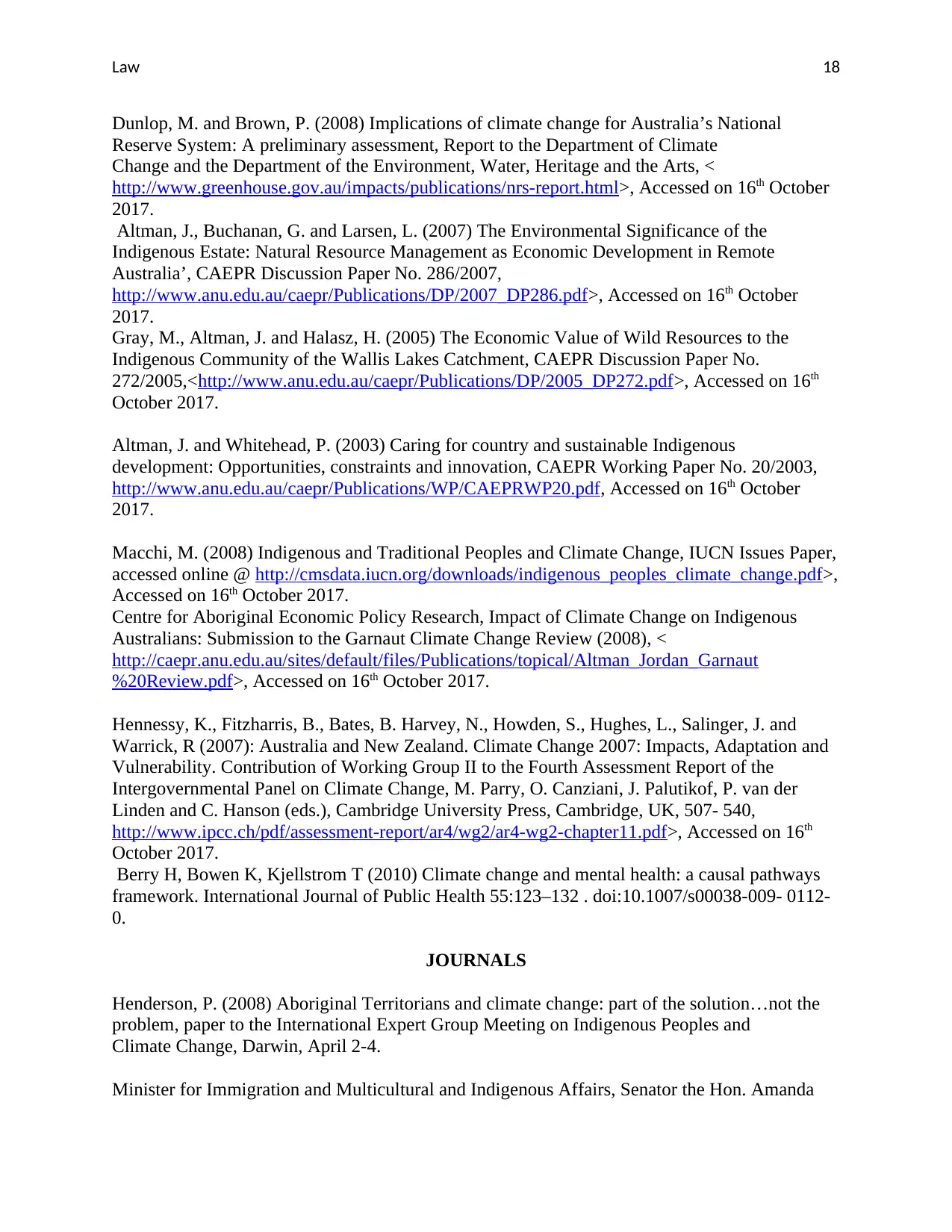
Law 18
Dunlop, M. and Brown, P. (2008) Implications of climate change for Australia’s National
Reserve System: A preliminary assessment, Report to the Department of Climate
Change and the Department of the Environment, Water, Heritage and the Arts, <
http://www.greenhouse.gov.au/impacts/publications/nrs-report.html>, Accessed on 16th October
2017.
Altman, J., Buchanan, G. and Larsen, L. (2007) The Environmental Significance of the
Indigenous Estate: Natural Resource Management as Economic Development in Remote
Australia’, CAEPR Discussion Paper No. 286/2007,
http://www.anu.edu.au/caepr/Publications/DP/2007_DP286.pdf>, Accessed on 16th October
2017.
Gray, M., Altman, J. and Halasz, H. (2005) The Economic Value of Wild Resources to the
Indigenous Community of the Wallis Lakes Catchment, CAEPR Discussion Paper No.
272/2005,<http://www.anu.edu.au/caepr/Publications/DP/2005_DP272.pdf>, Accessed on 16th
October 2017.
Altman, J. and Whitehead, P. (2003) Caring for country and sustainable Indigenous
development: Opportunities, constraints and innovation, CAEPR Working Paper No. 20/2003,
http://www.anu.edu.au/caepr/Publications/WP/CAEPRWP20.pdf, Accessed on 16th October
2017.
Macchi, M. (2008) Indigenous and Traditional Peoples and Climate Change, IUCN Issues Paper,
accessed online @ http://cmsdata.iucn.org/downloads/indigenous_peoples_climate_change.pdf>,
Accessed on 16th October 2017.
Centre for Aboriginal Economic Policy Research, Impact of Climate Change on Indigenous
Australians: Submission to the Garnaut Climate Change Review (2008), <
http://caepr.anu.edu.au/sites/default/files/Publications/topical/Altman_Jordan_Garnaut
%20Review.pdf>, Accessed on 16th October 2017.
Hennessy, K., Fitzharris, B., Bates, B. Harvey, N., Howden, S., Hughes, L., Salinger, J. and
Warrick, R (2007): Australia and New Zealand. Climate Change 2007: Impacts, Adaptation and
Vulnerability. Contribution of Working Group II to the Fourth Assessment Report of the
Intergovernmental Panel on Climate Change, M. Parry, O. Canziani, J. Palutikof, P. van der
Linden and C. Hanson (eds.), Cambridge University Press, Cambridge, UK, 507- 540,
http://www.ipcc.ch/pdf/assessment-report/ar4/wg2/ar4-wg2-chapter11.pdf>, Accessed on 16th
October 2017.
Berry H, Bowen K, Kjellstrom T (2010) Climate change and mental health: a causal pathways
framework. International Journal of Public Health 55:123–132 . doi:10.1007/s00038-009- 0112-
0.
JOURNALS
Henderson, P. (2008) Aboriginal Territorians and climate change: part of the solution…not the
problem, paper to the International Expert Group Meeting on Indigenous Peoples and
Climate Change, Darwin, April 2-4.
Minister for Immigration and Multicultural and Indigenous Affairs, Senator the Hon. Amanda
Dunlop, M. and Brown, P. (2008) Implications of climate change for Australia’s National
Reserve System: A preliminary assessment, Report to the Department of Climate
Change and the Department of the Environment, Water, Heritage and the Arts, <
http://www.greenhouse.gov.au/impacts/publications/nrs-report.html>, Accessed on 16th October
2017.
Altman, J., Buchanan, G. and Larsen, L. (2007) The Environmental Significance of the
Indigenous Estate: Natural Resource Management as Economic Development in Remote
Australia’, CAEPR Discussion Paper No. 286/2007,
http://www.anu.edu.au/caepr/Publications/DP/2007_DP286.pdf>, Accessed on 16th October
2017.
Gray, M., Altman, J. and Halasz, H. (2005) The Economic Value of Wild Resources to the
Indigenous Community of the Wallis Lakes Catchment, CAEPR Discussion Paper No.
272/2005,<http://www.anu.edu.au/caepr/Publications/DP/2005_DP272.pdf>, Accessed on 16th
October 2017.
Altman, J. and Whitehead, P. (2003) Caring for country and sustainable Indigenous
development: Opportunities, constraints and innovation, CAEPR Working Paper No. 20/2003,
http://www.anu.edu.au/caepr/Publications/WP/CAEPRWP20.pdf, Accessed on 16th October
2017.
Macchi, M. (2008) Indigenous and Traditional Peoples and Climate Change, IUCN Issues Paper,
accessed online @ http://cmsdata.iucn.org/downloads/indigenous_peoples_climate_change.pdf>,
Accessed on 16th October 2017.
Centre for Aboriginal Economic Policy Research, Impact of Climate Change on Indigenous
Australians: Submission to the Garnaut Climate Change Review (2008), <
http://caepr.anu.edu.au/sites/default/files/Publications/topical/Altman_Jordan_Garnaut
%20Review.pdf>, Accessed on 16th October 2017.
Hennessy, K., Fitzharris, B., Bates, B. Harvey, N., Howden, S., Hughes, L., Salinger, J. and
Warrick, R (2007): Australia and New Zealand. Climate Change 2007: Impacts, Adaptation and
Vulnerability. Contribution of Working Group II to the Fourth Assessment Report of the
Intergovernmental Panel on Climate Change, M. Parry, O. Canziani, J. Palutikof, P. van der
Linden and C. Hanson (eds.), Cambridge University Press, Cambridge, UK, 507- 540,
http://www.ipcc.ch/pdf/assessment-report/ar4/wg2/ar4-wg2-chapter11.pdf>, Accessed on 16th
October 2017.
Berry H, Bowen K, Kjellstrom T (2010) Climate change and mental health: a causal pathways
framework. International Journal of Public Health 55:123–132 . doi:10.1007/s00038-009- 0112-
0.
JOURNALS
Henderson, P. (2008) Aboriginal Territorians and climate change: part of the solution…not the
problem, paper to the International Expert Group Meeting on Indigenous Peoples and
Climate Change, Darwin, April 2-4.
Minister for Immigration and Multicultural and Indigenous Affairs, Senator the Hon. Amanda
You're viewing a preview
Unlock full access by subscribing today!
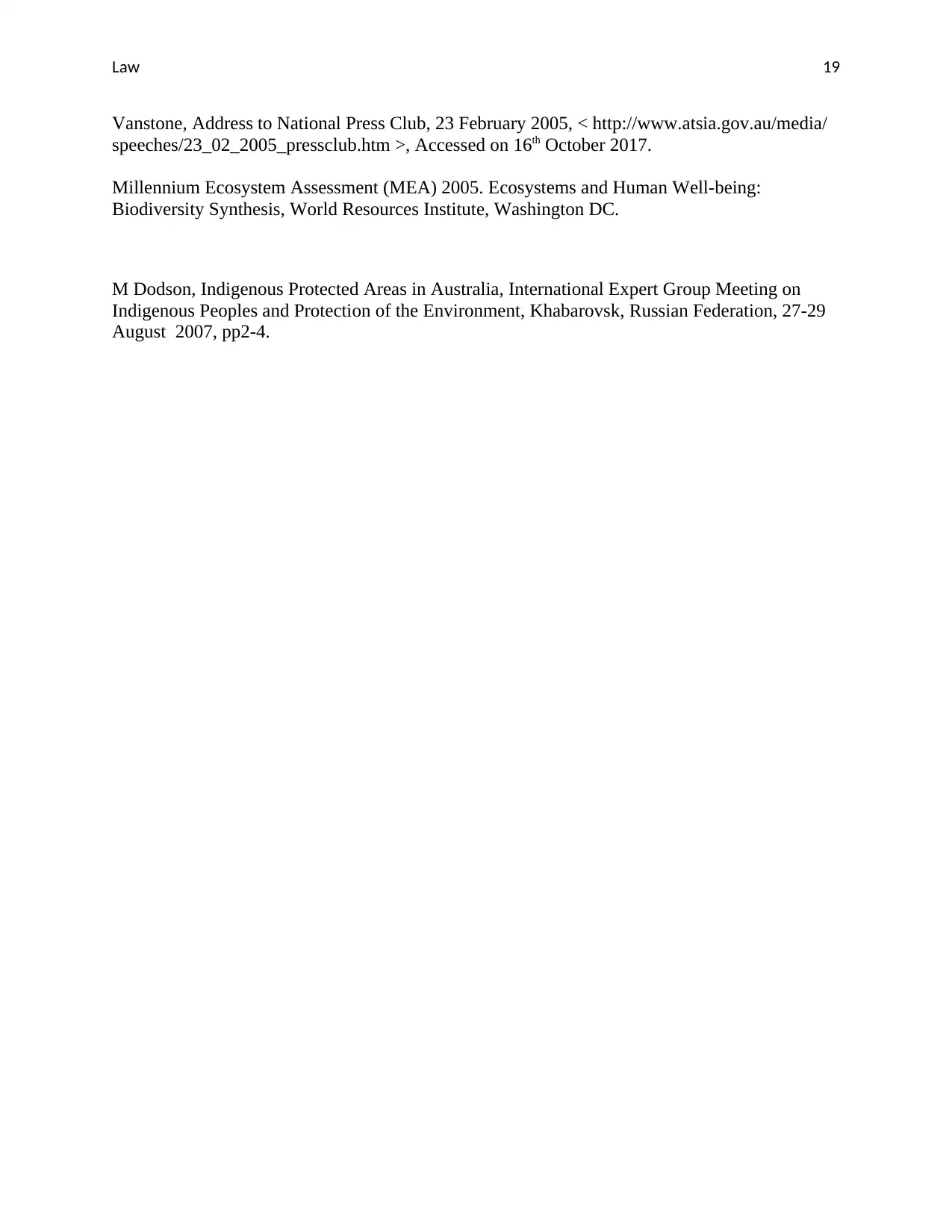
Law 19
Vanstone, Address to National Press Club, 23 February 2005, < http://www.atsia.gov.au/media/
speeches/23_02_2005_pressclub.htm >, Accessed on 16th October 2017.
Millennium Ecosystem Assessment (MEA) 2005. Ecosystems and Human Well-being:
Biodiversity Synthesis, World Resources Institute, Washington DC.
M Dodson, Indigenous Protected Areas in Australia, International Expert Group Meeting on
Indigenous Peoples and Protection of the Environment, Khabarovsk, Russian Federation, 27-29
August 2007, pp2-4.
Vanstone, Address to National Press Club, 23 February 2005, < http://www.atsia.gov.au/media/
speeches/23_02_2005_pressclub.htm >, Accessed on 16th October 2017.
Millennium Ecosystem Assessment (MEA) 2005. Ecosystems and Human Well-being:
Biodiversity Synthesis, World Resources Institute, Washington DC.
M Dodson, Indigenous Protected Areas in Australia, International Expert Group Meeting on
Indigenous Peoples and Protection of the Environment, Khabarovsk, Russian Federation, 27-29
August 2007, pp2-4.
1 out of 19
Related Documents
Your All-in-One AI-Powered Toolkit for Academic Success.
+13062052269
info@desklib.com
Available 24*7 on WhatsApp / Email
![[object Object]](/_next/static/media/star-bottom.7253800d.svg)
Unlock your academic potential
© 2024 | Zucol Services PVT LTD | All rights reserved.





